The Spar Shop
at the Historical Seaport
- Products/Pricing

GHHSA Links
Other links, new harbor's best greenhouse kits.
| The Spar Shop has announced the immediate availability of . Designed for the small city or a modest back yard, the Harbor's Best Greenhouse Kit is priced for today's budgets. |
We turn wood masts and spars up to 40 inches in diameter and 122 feet long!
| We are a unique operation specializing in ship's , as well as custom columns and poles. We also provide custom milling of wood gaffs, booms, timbers, beams and cants. Learn more about the process for . Call us now at 800-200-5239 to discuss your project or for a ! |
We have the largest tracer-lathe in North America.
| Our 10,000-square-foot drive-through shop is one of a kind, featuring the largest tracer-lathe in North America. We can turn logs up to 40 inches in diameter and 122 feet in length. With our two sawmills, we can mill logs as large as six feet in diameter, and create timbers as long as 100 feet or more. Our Job Shop offers of movie set pieces, museum exhibits and thematic elements for as well as short-run-production woodworking projects. |
Watch our Spar Shop crew turn a large mast and talk about our services.
| For more video about the Spar Shop, check out our . |
We work with wooden tall ship owners, maritime museums, and movie companies.
- Twentieth Century Fox Films ( Water for Elephants )
- Paramount Pictures ( Star Trek: Generations )
- Triad Productions ( The Great American West )
- 1st Mate Productions/Disney Studios ( Pirates of the Caribbean I )
- 2nd Mate Productions/Disney Studios ( Pirates of the Caribbean II )
- 3rd Mate Productions/Disney Studios ( Pirates of the Caribbean III )
- Stonewerks Productions ( Blackbeard )
- Rice Gorton Pictures
- Schooner Zodiac , Bellingham, WA
- Sloop Providence , Providence, RI
- Schooner Virginia , Norfolk, VA
- Schooner Amistad , Mystic, CT
- Schooner Bill of Rights
- Star of India , San Diego Maritime Museum, San Diego, CA
- Ship Niqa , Grand Caymen
- Schooner Mystic , Mystic, CT
- Brig Lady Washington , Aberdeen, WA
- Topsail ketch Hawaiian Chieftain , Westport, WA
- Caravel redondo Nina , St. Thomas, VI
- Square-topsail schooner Pride of Baltimore II , Baltimore, MD
- Brigantine Fair Jeanne , Ottawa, ON
- Full-rigged ship Bounty , North Myrtle Beach, SC
- Schooner Denis Sullivan , Milwaukee, WI
- Brigantine Irving Johnson , San Pedro, CA
- Schooner Lady Maryland , Baltimore, MD
- Full-rigged ship Joseph Conrad , Mystic, CT
- Columbia River Maritime Museum, Astoria, OR
- Aberdeen Museum of History, Aberdeen, WA
- Commencement Bay Maritime Museum, Tacoma, WA
- Garibaldi Museum, Garibaldi, OR
- Klumb Lumber Co., Jackson, MS
- Community Builders, Mineral, VA
- Washington State Dept. of Parks & Recreation
- Grays Harbor College
- John Simons
- Capt. John Johnson
Contact us about your large-scale specialty woodworking needs today!
Call the Spar Shop at the Historical Seaport today for an estimate on your large-scale milling, turning, or custom woodwork needs. You can reach us at 360-532-8611 or 800-200-5239. Or email us at [email protected] . Historical resources on wooden mast-making and spar-making
Grays Harbor Historical Seaport Authority, 712 Hagara St., Aberdeen, Wash. 98520 800-200-5239 | [email protected] | All images copyright GHHSA.
- For Sale/Wanted
- Readers Tips
- Your Yarns.
- Restoration
- Miscellaneous
- DIY Boat Yards
- Boat Building
- Cabin Cruisers
- Free Boat Plans
- Begin Boating
- Boating Terms
- Ropes and Rigs
- Just for Fun
- Celestial Navigation
- Passage Planning
- VHF Marine Radio
- Sailing Rigs
Wooden Mast and Spar Building
A mast or spar made from wood not only looks and feels good but it also takes advantage of the naturally ability that trees have developed over the centuries for creating a tall, strong, flexible pole.
Those tall straight pine and fir trees are able to grow to such heights and survive in wind storms because their natural elasticity absorbs the shock loads caused by gusting winds.
Structural Considerations
Solid/grown spars, rounding the square.
- Built Spars
- Your comments and suggestions
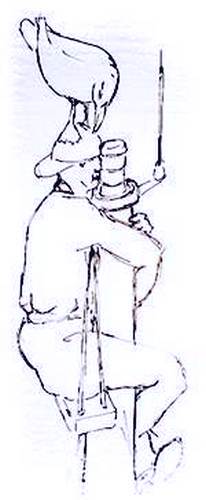
There are several reasons why soft woods are the chosen type of timber used in the making of masts and spars.
The first and most obvious is that so any soft wood trees grow exceedingly tall and straight.
And because they have grown so tall and straight they have developed the ‘elasticity’ to withstand all that the elements can throw at them.
Soft woods are also more likely to be lighter in weight.
Sitka Spruce (Silver, Tideland or Menzies Spruce) has long been the top choice for mast builders.
However many other spars have been built using whatever light, straight-grained wood was available, such as those shown below.
- Douglas fir (British Columbian, Oregon, Idaho, Red, pine also known as Red or Yellow fir)
- Scots pine (European redwood, Northern pine, Red pine, Redwood, Scots fir, Norway fir, Swedish fir, Finish fir)
- Port Orford cedar (Oregon cedar, White cedar, Ginger pine, Lawson’s cypress)
When choosing a timber look for one that is as light and straight grained as possible with, hopefully few knots.
However, a few small ones knots can be acceptable.
The timber should ideally be seasoned, especially if you are building a hollow spar.
I have heard of solid masts being made from green poles.
But green timber is more likely to develop shakes and will be less able to absorb any preservative, oil, varnish or whatever you use as a finish.
A mast/spar needs both strength and stiffness and be able to resist fatigue.
Sometimes these characteristics can be conflicting.
Strength or resistance to breaking in wood involves its elasticity which allows the wood to bend to absorb stresses.
Whereas stiffness is the resistance to bending.
All spars need to be able to absorb the shock of a gust which the wood absorbs by bending but too much bend will spoil the sail shape so a happy compromise is needed.
And stresses will differ depending on the types of rig and whether the mast keel stepped, deck stepped or in a tabernacle.
Another consideration is weight aloft.
Keeping weight within reasonable bounds is just one of the reasons for using soft woods.
It is also one reason for building a hollow mast.
However, most spars taper towards the top, as the diameter becomes smaller so the weight becomes less.
For the average cruising yacht the weight differences between a solid and a hollow spar are hardly significant.
The other advantage of the hollow, built spar is that it can be made from easily available timber sizes, and with a minimum of waste.
The simplest, easiest and least wasteful spars are produced from ‘grown’ timbers.
I theory it should be possible to acquire a trunk which has the length and taper needed for your spar.
In practice you will have to do some shaping, tapering and rounding.
While traditionally masts and spars were spherical, they don’t have to be.
However, in my opinion a spherical mast will produce the least turbulence to the air passing over the rig.
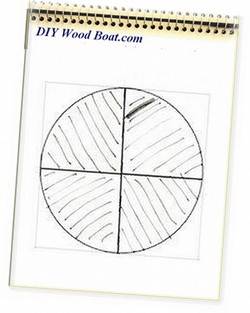
It is possible to make a spherical spar from one piece of square cross-section timber.
However, it will be much easier to source timers of smaller cross-section and then build the spar up from them.
And the advantage is that the grain can then be arranged in a radial fashion.
Building a spar from separate parts does require very careful attention to the gluing surfaces, they must be closely mating and the actual gluing must be precise.
If you are confident in your carpentry and gluing skills, short lengths can be scarffed to produce the required length.
Scarf joints are best at least ten times the thickness of the piece and when the various pieces are assembled the joints should be staggered.
And remember to never ever cut a piece of wood to its exact length until you absolutely have to.
First determine the required diameter of your spar and then where you want your it to taper and by how much.
This will depend on the design of you rig.
You may want the spar to have no taper for some of its length/height, to just above the partners, then have a slight taper, perhaps as far as the spreaders, then a bit more of a taper up to the truck.
Always best to start with the wood a little wider, thicker, and longer than the finished dimensions.
Plane one surface flat and level with your longest plane, preferably a jointer.
Then mark the center line on this planed face.
Use a string stretched between tacks in the middle of each end, use this to make several center marks on the timber.
Then join the marks using a long, straight batten.
Repeat on the opposite face.
Now use the centreline as the datum from which to mark the width of your mast at intervals along its length.
Then back to the batten to connect these marks.
You can now cut the outline of your mast to this drawn profile but cut it oversized as you still need to plane the timer square.
Now plane these two sawn, tapered faces flat and square to the original planed surface.
Repeat the steps for marking the center line and profile on these two new faces.
Cut this outline and plane these sides flat and square to their adjacent sides.
You now have a spar tapered to your requirement but it is still square in cross-section.
Now you need to start rounding the square.
So now you’ve got a nicely tapered, planed but square, four sided spar.
Next job is to plane off the four corners to give you an eight sided spar.
Then plane off those eight corners to give you a sixteen sided spar, which can then easily be rounded using sandpaper.
But before you start taking off the corners you need to mark the depth of the bevels.
The simple way is to draw a circle on the face of the timber with a compass.
The center of the circle will be on the centreline and the edge of the circle right on the edge of the face.
Then draw a line from the center of the circle, at 45 degree to the centreline and mark where it crosses the circle.
This mark is the edge of the bevel.
Do this for every transition point and as many points in between as possible, the more the merrier and do it foe both sides of the circle.
These marks can then be joined using your batten.
One you have planed the spar down to eight sides you can use the same method to mark it up for reducing it to sixteen sides.
But now the line from the center of the circle to the circumference needs to be 67 ½ degrees.
Now unless you are building a massive spar getting from 16 sides to 32 sides using the above measuring technique is going to become fiddly.
At this stage it is quicker to use your eye and your judgment to plane off the remaining corners.
Then the final rounding can be done by sanding.
Start with 60 or 80 grit paper for the initial shaping, then work the grits for finishing.
Use long strips of sandpaper wrapped around the spar and pull it backwards and forwards in a long, spiralling motion.
Occasionally sand along the length of the mast to help fair out any uneven spots.
Here is an easy way to mark out a tapered octagon using only one setting of your compass.

Building a spar is obviously much more difficult than simply shaping a solid pole.
However, if a pole of the required dimensions is not available building the spar might be the only option.
Built spars can be either solid or hollow.
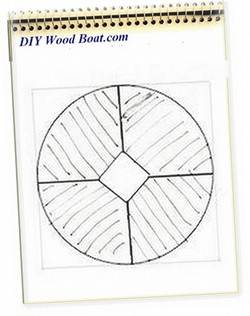
But if you are building one it is relatively simple to make it hollow and thus save weight aloft and create a central channel for masthead wiring.
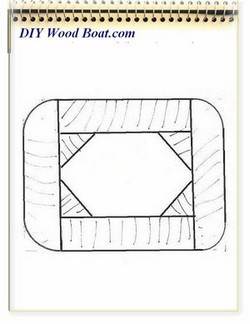
Building a simple cylindrical spar as those shown above from ‘square’ timbers does require wasting quite a lot of that expensive wood when 'rounding the square'.
One can build an almost waste free hollow spar which would suit a conventional bermudan rig.
However, a ‘square’ section with rounded corners such as this would be unsuitable for any rig which uses mast hoops or parrel beads or a lug rig where the spar turns against the mast.
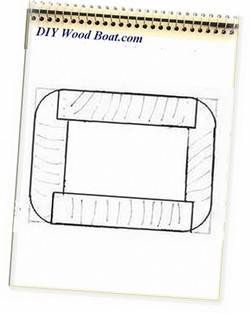
The next problem when creating a hollow spar is that unlike the solid mast the taper cannot be created afterwards.
Any taper to the finished spar needs to be cut from the staves before they are assembled.
There have been several configurations used to increase the gluing areas across the width of built staves.
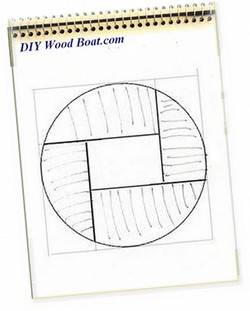
And several configurations which attempt to reduce wastage and at the same time produce large gluing surfaces.
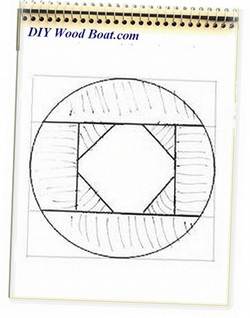
Unfortunately while they will produce superb, strong spars they call for increasingly complex carpentry.
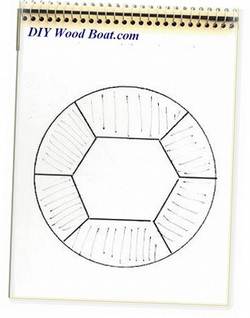
The ‘Birdsmouth’ technique developed by Nobles of Bristol UK is perhaps one of the most successful of these techniques.
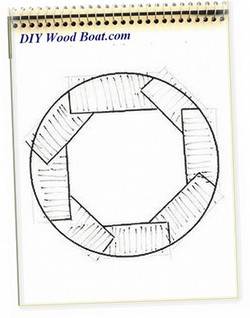
However, it is a technique which really requires access to woodworking machinery, such as profiling and planing machines.
Setting up your standing rigging can be greatly simplified by using ‘Spectra’.
‘Spectra’ is virtually stretch free and can be tied off without much weakening.
It offers a real alternative to expensive swaged fittings, can be easily maintained and it is corrosion-free.
Previous posts
See What Others Have Posted

Recent Articles
Boat Winches
Jun 21, 24 04:18 AM
You might like these

Knotty wood, problems with boat building timber.
Knotty wood, how to avoid structural problems with knots in lumber when using softwood timber for fitting out and boat joinery

Build a Boat, tips for the DIY Wooden Boat Builder.
How to Build a Boat, Wooden Boat Building methods for the DIY, backyard, self-builders explained, carvel, lapstrake and plywood

Wood Screws for Boat Building and Repair.
Wood Screws are the most widely used and versatile fasteners used on wooden boats. Which type to use and how to use them

Wood, Environmentally Friendly Boat Building Lumber.
Make sure that the Wood that you buy and use is sustainably grown and harvested.
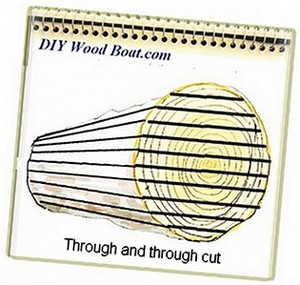
Timber, Lumber for Boat Building.
A brief description of the most common Timber used for building Wooden Boats how to choose wood for your project boat

Timber Properties
A brief guide to timber properties and wood, characteristics such as strength, stiffness and elasticity for choosing lumber for wooden boat building and restoration.
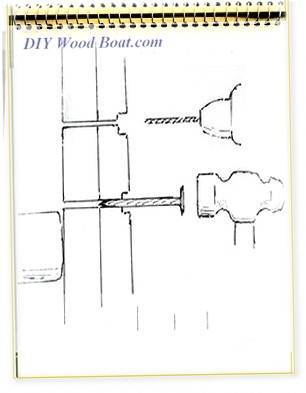
Rivets and Copper Rove Wood Boat Fastenings.
How to use Copper Rivets and Roves construction guide to fasteners on your wooden boat.

Ring Nails for Marine Fastening.
Ring Nails sometimes call Gripfast or ring shank, silicon bronze boat nails are renowned for their holding power. but how to get them out?

Plywood and Veneer Guide for Marine use.
A guide to plywood for boat building and why you should use the best marine grade you can afford.

Glue for Wooden Boat Building
Which Wood Glue to use when building or restoring a wooden boat, resorcinol to epoxy.
Owens Boats
Jun 05, 24 12:14 PM
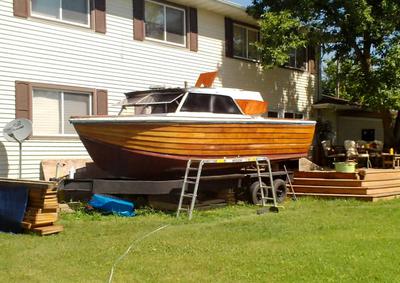
Penn Yan Boats
May 28, 24 07:51 AM
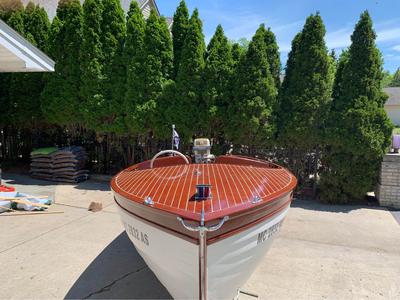
The Dipping Lug Sail
The dipping lug sail, is perhaps the most efficient and cheapest, type of sailing rig especially for small sailboats however it isn't as handy as the standing lugger or the balanced lugsail.
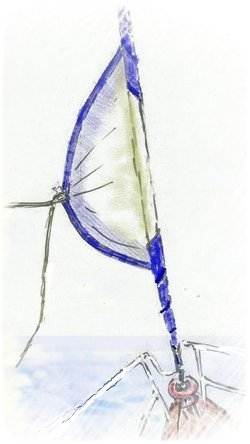
UV Strip for Furling Sails
UV Strip, notes on repairing, fitting and replacing a sacrificial UV protection strip on furling sails using acrylic or UV protected Dacron.
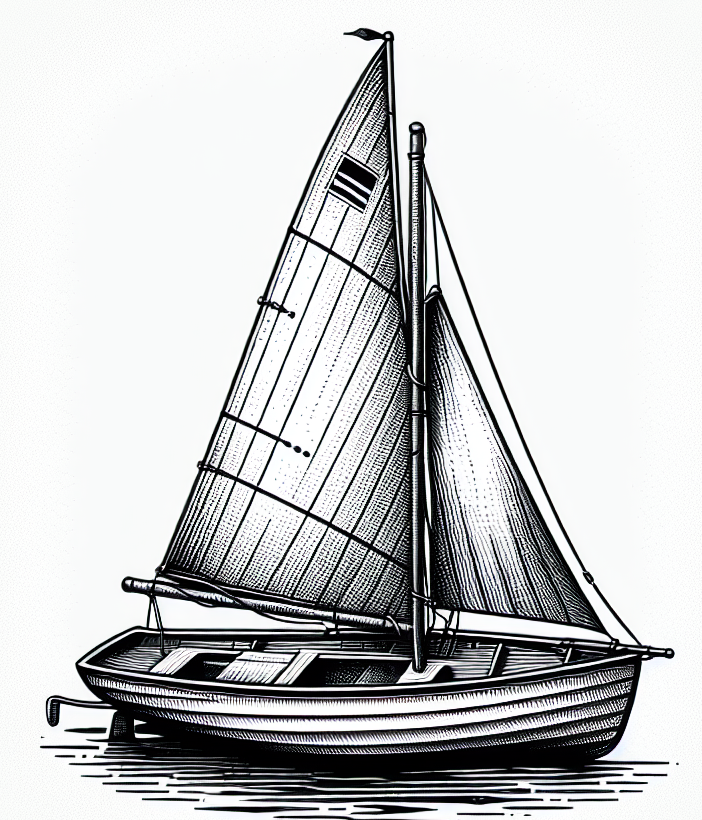
Sailing Rigs, a Guide to Sail Shapes.
The basic shape of the Sailing Rigs most commonly found on wooden sailing boats of every size.

About sail cloth and the different materials for DIY sail making and the average leisure sailor.

Sail Balance
Notes on Sail Balance, designing a sailing rig, how set the relationship between the center of effort and the center of lateral resistance.

Lug Rigs for large and small sailboats.
Sailors have been using Lug Rigs for centuries because of their unique sailing abilities.
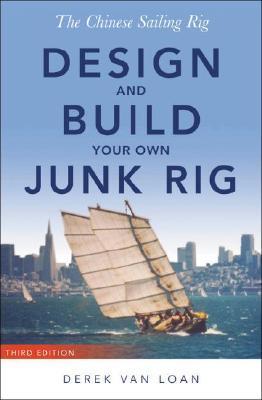
Junk Rig Conversion
Structural considerations for a Junk rig conversion of a wooden boat from bermudan rig to junk sail, where and how to site the mast.

Chinese Junk, the perfect cruising rig.
Chinese junk sail, why I rigged Mignonne with a Jukn Sail
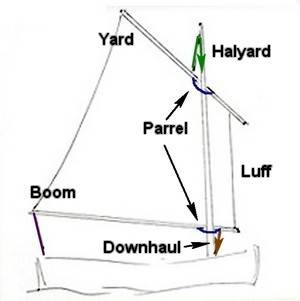
The Balanced Lugsail
The balanced lugsail is one of the best traditional rigs for small boats, cheap and easy to rig and sail it is a practical alternative to more expensive bermudan rigs.
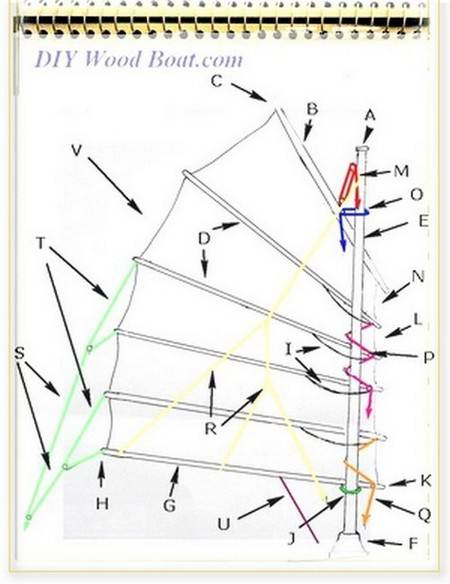
Junk Rig the ideal cruising sail.
How to rig a western version of the Chinese Junk Rig the basic lines and controls.
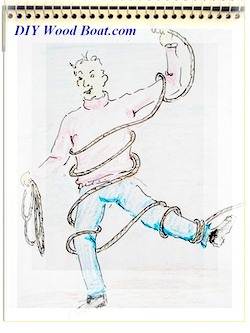
Ropes and Rigs for Boating.
Boating ropes and rigs, knots, sailing, line handling and line care, what all boaters need to know.
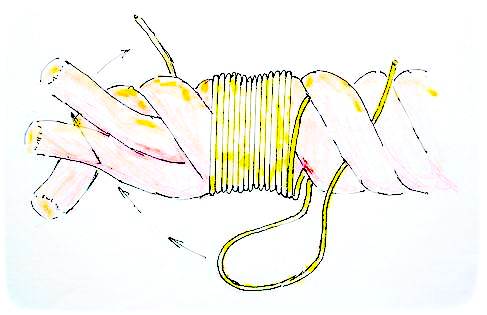
Whipping Boat Ropes
Whipping marine ropes to prevent the ends fraying, how to use whipping twine to prevent rigging and yacht ropes from untwisting.
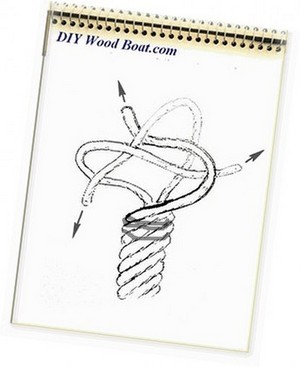
Splicing Three Strand Rope.
Splicing, tips and techniques, three strand eyes and rope ends, make your own dock lines why pay for something you can easily do yourself.
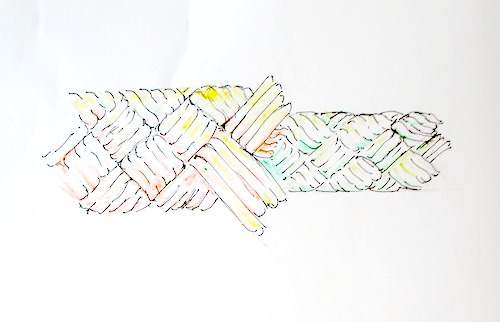
Rope types, what types, construction and materials to use on your boat when to use three strand and braided marine lines.
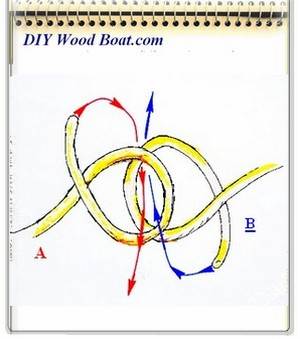
Knots for Sailors.
A brief description of and how to tie some of the most useful boating knots. Including some that every boater should know.
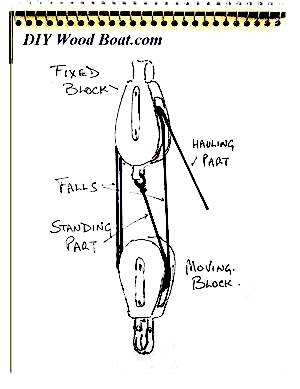
Blocks and Tackle lines and sheaves.
How Blocks and Tackle work to give mechanical advantage and how best to rig them.
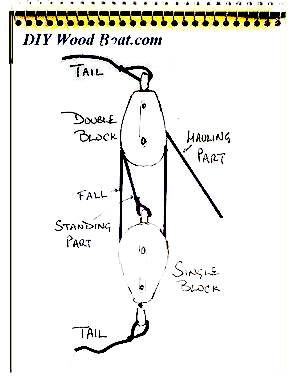
Handy Billy a traditional rope and sheave rig.
A Handy Billy made with two blocks and tackle can be used to give mechanical advantage wherever needed.
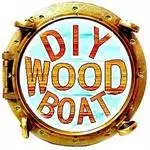
Privacy Policy
Advertising Policy
Cookie Policy

I am perfectly aware that the majority of Wooden Boat aficionados are sensible folk. However, I need to point out that I am an amateur wooden boat enthusiast simply writing in order to try to help other amateur wooden boat enthusiasts. And while I take every care to ensure that the information in DIY Wood Boat.com is correct, anyone acting on the information on this website does so at their own risk.
Shaw and Tenney Home
- Traditional Oars
- Sculls, Adirondack, Specialty and Large Oars
- Marine Hardware, Oarlocks, Leathers and Accessories
- Traditional Canoe Paddles
- Kayak Paddles
- SUP Paddles
- Artisan Canoe Paddles
- Paddling Accessories
Wooden Masts and Spars
- The Shaw & Tenney Whitehall
- Camp and Home
- Pack Baskets and Bags
- Miniature Paddles and Oars
- Custom Engraving
Shopping Cart
Shaw and tenney mobile nav.
- Gear & Apparel
- Awards & Engraving
Header Image

Custom-made for your boat.
Back to Top
How to Size Your Oars
To determine the correct length oar for your boat measure the distance between the port and starboard oar sockets. Then apply the Shaw and Tenney oar length formula to determine the oar length that will provide the correct 7:18 leverage ratio. This length will provide an oar where 7/25 the length is inboard of the oarlocks and 18/25 of the oar is outboard of the oarlocks. It is the ideal ratio to row almost all boats. Sized correctly, when rowing your hands will be 1 to 3 inches apart and you will be pulling directly towards your abdomen. If you are popping out of your oarlocks when rowing your oars are far too short. If you prefer an overlapping grip, add 6” to the calculated oar length. If you have more than one rowing station in your boat, measure both. Typically they will require two different length oars which is fine if you’re going to be rowing tandem and need two sets. Otherwise you’ll need to compromise the correct length to work properly in both stations. If you are rowing more than 75% in one station size the oar to that length. As always feel free to call us and were happy to help you select the correct oar length and blade style for your boat.
The Original Shaw & Tenney Oar Length Formula
To help our customers size their oars correctly, we’ve been using the same formula since 1858: Measure the distance between the center of the port and starboard oar sockets, which hold the oar locks on each gunnel. This is called the “span” between the oarlocks. Divide the span by 2, and then add 2 to this number. The result is called the “inboard loom length” of the oar. Multiply the loom length by 25, and then divide that number by 7. The result is the proper oar length in inches. Round up or down to the closest 6” increment.
How to Size Your Paddle
For traditional wooden paddles the ideal length for the Stern paddler is the bridge of your nose or 6 inches less than your height. For the bow paddler the paddle reaching the cleft of your chin or 9 inches less than your height is correct.
For our Racine paddle if you are over 5’6” tall select the 63-1/2” length and the shorter paddle if you are under5’-6”tall.
When paddling solo we typically recommend a bow length paddle. For Canadian style solo most paddlers prefer an even shorter paddle.
For paddling canoes when standing (yes our mother let us do this) a 69 inch or 72 inch paddle is usually about right.
Shaw and Tenney
Toll Free: 800-240-4867 207-866-4867 20 Water Street, PO Box 213, Orono, Maine 04473
Shop Shaw & Tenney
More information.
- Privacy Policy
- Terms & Conditions
Stay In Touch with Shaw & Tenney
© 2021 Shaw & Tenney, Inc.
Have a question or need some help?
Call us at 800-240-4867 or click here to send us an email . Thanks!
Refastening a Wooden Hull - Season 4, Episode 1 Now Available!
How to Build a Wooden Mast
A tapered, oval new york 32 spar from the original plans.
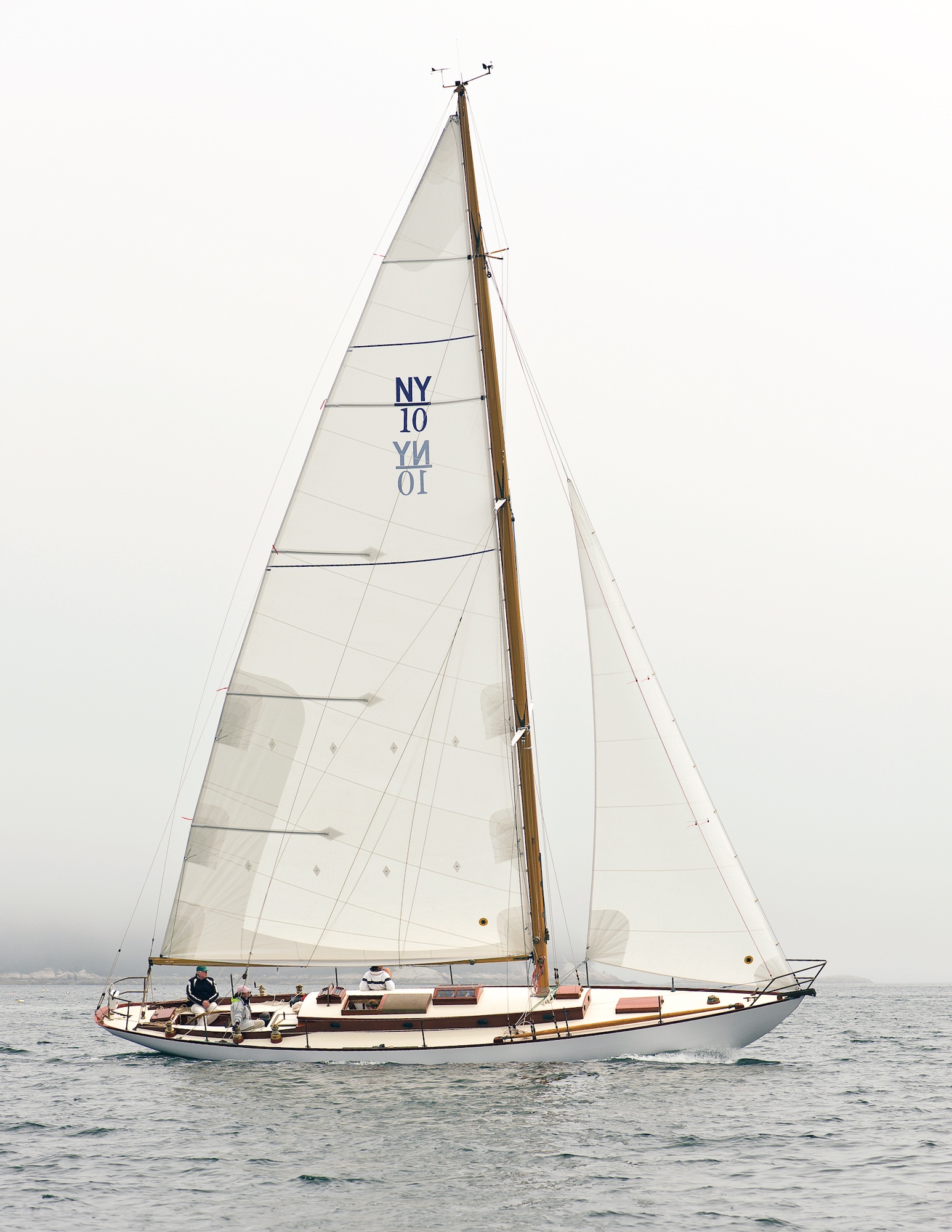
ISLA, New York 32 No.10 (of a total of 20), was thoroughly rebuilt last year by Buzzards Bay Yacht Services of Mattapoisett, Massachusetts. The job included a new mast, whose construction is detailed on the following pages.
W hen my company was hired to restore New York 32 No. 10, ISLA, in 2008, the boat had been out of service for over 25 years. The 20-boat New York 32 fleet was designed by Sparkman & Stephens in 1935 and built over the winter of 1935–36 by Henry B. Nevins of City Island, New York. When we found her, ISLA was a virtual time capsule, with an intact original interior and a complete set of original hardware. But the hull and deck were tired, to say the least, and the spars were beyond repair. So, included in the work list were a new mast and boom.
The New York 32 carries a hollow, oval mast measuring 63′ 5″. The owners were committed to maintaining ISLA’s originality, so we acquired the original spar drawings from the S&S plan collection at Mystic Seaport. These included ample detail: spreaders, tangs, boom, and masthead, along with the overall mast plan. The following steps describe how we turned those drawings into a new mast for ISLA.
Ordering and Preparing Lumber ISLA’s mast is built of Sitka spruce, which has long been prized by sparmakers for its long, clear lengths, light weight, and impressive strength for that weight. From the plans we developed a lumber list for the mast, boom, and spreaders. While it is still possible to acquire excellent-quality Sitka spruce, it takes some searching and a keen eye for defects. We required at least 12/4 stock to fashion the forward and after staves.
For spars, it’s imperative that the wood be dry (below 15 percent moisture content) and free of defects. The grain must be vertical. Our first attempt to procure lumber for this mast resulted in us receiving a batch of 12/4 Sitka spruce that was case-hardened. It was dry to both the touch and to the moisture meter, but once milled and its center exposed, its moisture content went off the scale. When we tried to rip it on the tablesaw, it pinched the saw’s blade and stopped the saw. We replaced that batch of wood with properly dried material, and learned a lesson in the process.
We ran the rough-sawn boards we had purchased through the thickness planer to take “fur” off of each one, allowing for a better inspection of the surface of the wood. When doing so, we kept in mind the minimum thickness of the staves, so we wouldn’t carelessly plane off too much. With this done, we examined each board, measuring its usable portion, marking visible defects, and labeling each piece for its intended location in the mast. A board with tight grain is slightly denser and thus heavier than one with wider ring spacing; we strived to locate these heavier pieces toward the bottom of the spar. If another board had slight grain runout, we’d consider using it in the mast’s heel where it is under less stress and is backed by solid blocking. It’s also important to keep in mind the locations of the scarfs when selecting the lengths of stock that will compose each stave, for the scarfs must be staggered.
Utilizing the Drawing
The drawing shown here is an illustration of the original Sparkman & Stephens mast plan for the New York 32, whose vertical scale was compressed in order to fit the mast’s dimensions onto a single sheet of paper. From the drawing we created a table of offsets for the mast. To do this we drew a series of stations, 5′ apart, perpendicular to the mast’s centerline. We did this for both the side and forward views of the mast.
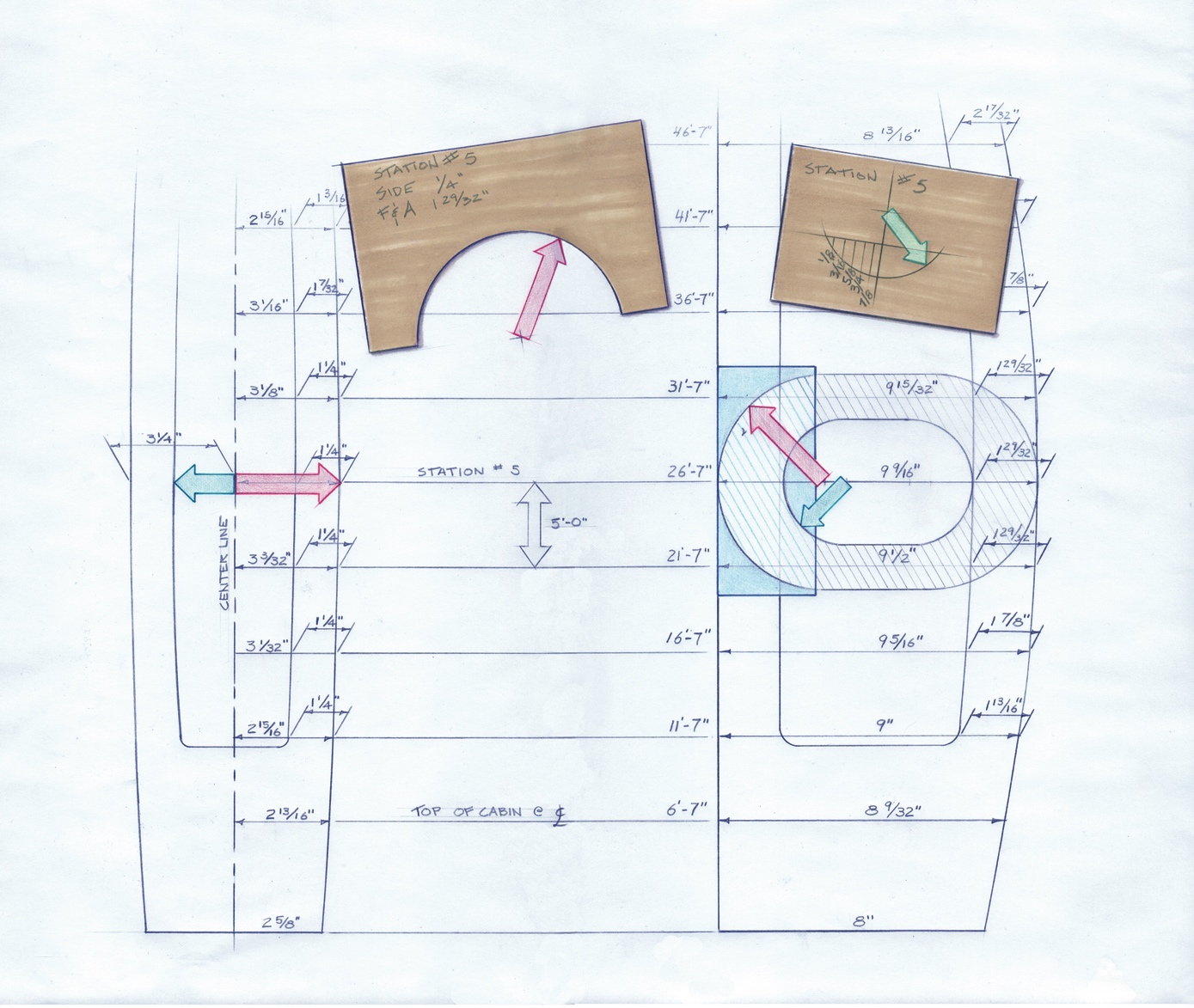
The drawing shown here is an illustration of the original Sparkman & Stephens mast plan for the New York 32
For the forward and after staves, we recorded the overall thickness of the stave (that is, its thickness before hollowing) and its half width. For the side staves, we recorded the thickness and width at each station. We converted the mast plan drawing from 32nds of an inch to decimal units, which I find best when working to close tolerances using digital calipers. We then made up 10″ × 10″ lauan templates on which to draw the sectional shape of the mast at each station. Since the forward and after profiles are arcs of a circle, we transferred these shapes from the drawing to the lauan with the aid of a compass. After each shape was transferred we cut out these lauan templates with a bandsaw. On each template, we also recorded the sidewall thickness, forward and after wall thicknesses, and distance from the heel of the mast. Building this New York 32 mast as was done originally requires hollowing out the thick forward and after staves in order to lighten their weight. So, once again using the mast plan, we made templates for the mast’s inside shape at each section.
The Spar Bench
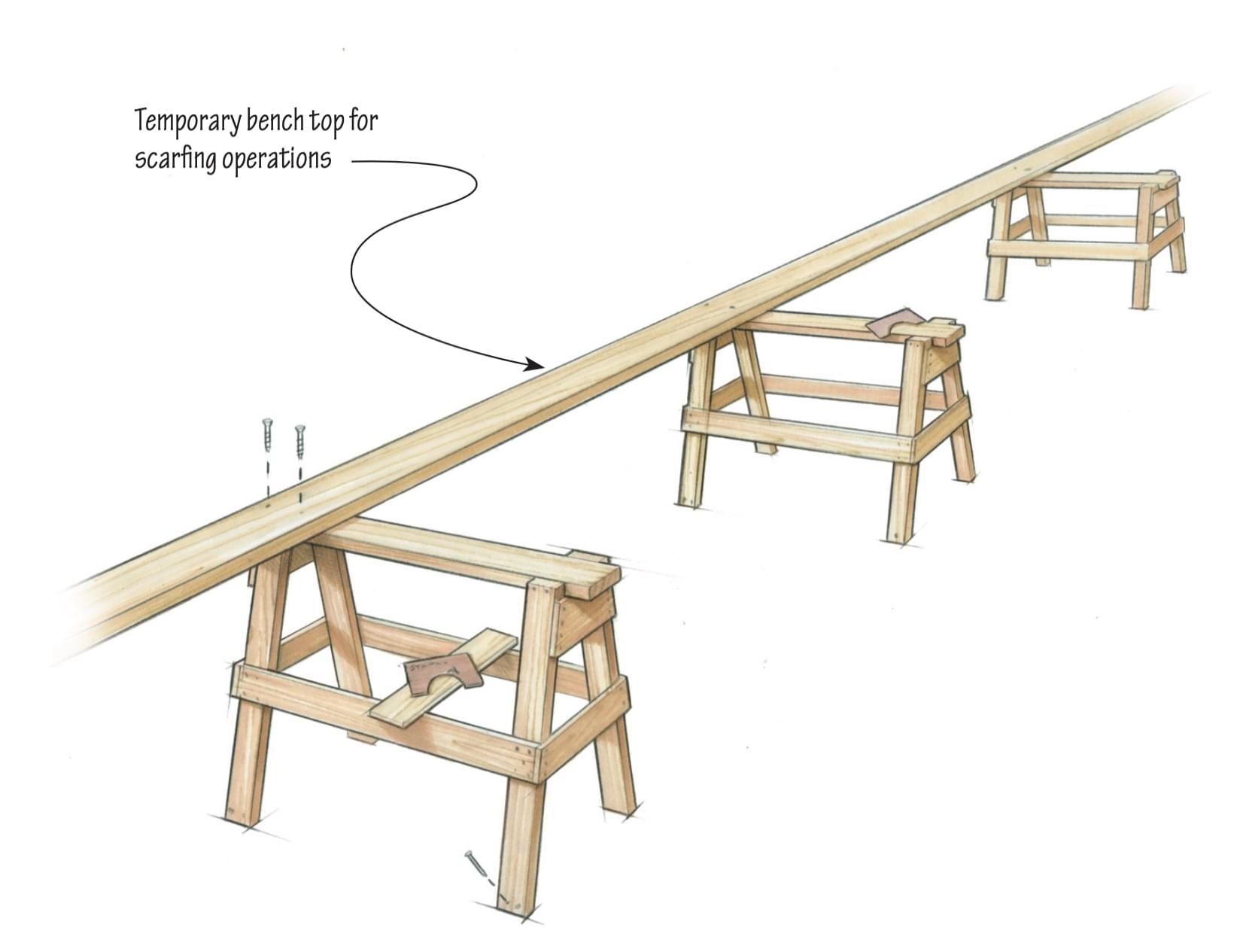
The first step in building the mast is to construct a spar bench. We wanted a sturdy bench that was straight and set at a good working height. Typically, a spar bench comprises a series of sturdy sawhorses spaced 5′ apart and fastened securely to the shop floor. Identical wooden sawhorses work well for this; once they were secured to the floor, a mason’s string was run to assure that the tops were all in the same plane; the tops were then shimmed as needed to achieve this. The 2 × 10 plank seen here being screwed to the sawhorses is to support the staves during the scarfing operation, and will later be removed.
Gluing Up Full-Length Staves
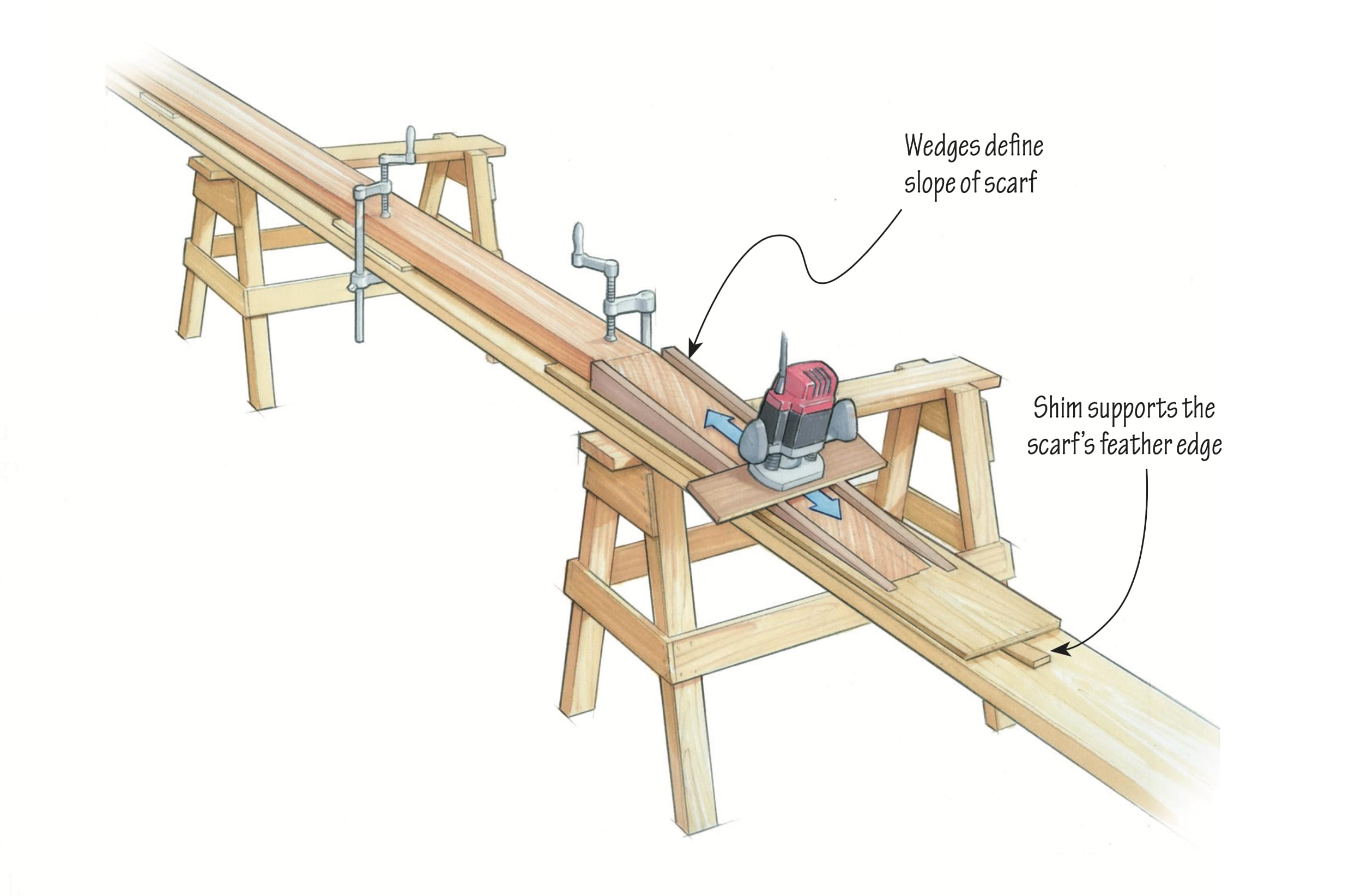
On our nice, solid bench, we laid out the wood for each of the mast’s four staves end-to-end and developed a final scarf plan. We planed the stock to the maximum designed thickness for the forward and after staves (2.875″) and for the side staves (1.25″). Then we scarfed the stock together to create the full-length staves. Careful layout and labeling were required for this step. We examined the stock and put the most visually pleasing sides facing out, and we spread out the scarf locations to avoid clustering them. Scarfs were cut to a slope of 12 to 1, with their lines drawn onto the edges of each piece. They were rough-cut on the bandsaw, and then finished with a jig and a router. With the scarfs cut, we assembled the pieces dry and ran a string down each of their centerlines to confirm that each of the four full-length staves, once glued, would be straight.
When we were certain that the staves would be straight and true, we screwed blocks to the spar bench to chock them in place. The individual pieces could then be removed from the bench, turned over for gluing, and placed back in their precise positions. The final step in preparing the scarf for epoxy glue was to rough up the surface of the glue joint. Eighty-grit sandpaper backed by a long block works well for this, as does the technique we used: a Japanese pull saw drawn across the grain so its teeth combed the surface. (This process is for epoxy gluing only; resorcinol and other glues rely on smooth mating surfaces.)
Once the surface was roughed up, we vacuumed both faces of the joint and then wiped them with a clean rag and denatured alcohol until the rags came up clean. We then wet out both gluing surfaces with straight epoxy and allowed that to stand for several minutes while it penetrated the wood. Dry spots were wetted a second time. We then applied epoxy thickened with colloidal silica to one face of the joint. Using large bar clamps and modest pressure, we clamped the joints, making sure we had a nice, even glue squeeze-out.
Tapering the Staves
Once the staves were glued full-length, we selected the aft stave, blocked it straight on the spar bench, and snapped a centerline. Then, using the information from the lauan templates and the offset table, the points representing the stave’s profile were laid out and connected with a long, limber batten. One of the side staves was marked similarly.
We rough-cut the profiles with a worm-drive circular saw being careful to leave the lines intact. We then cut closer with a power plane, and then shaved precisely to the lines with an appropriate hand plane, making sure that the edges stayed perfectly square. With one stave of each profile now complete, we used each as a template for its mirroring stave, making the final cuts with a router and bearing bit to complete the second pair of staves.
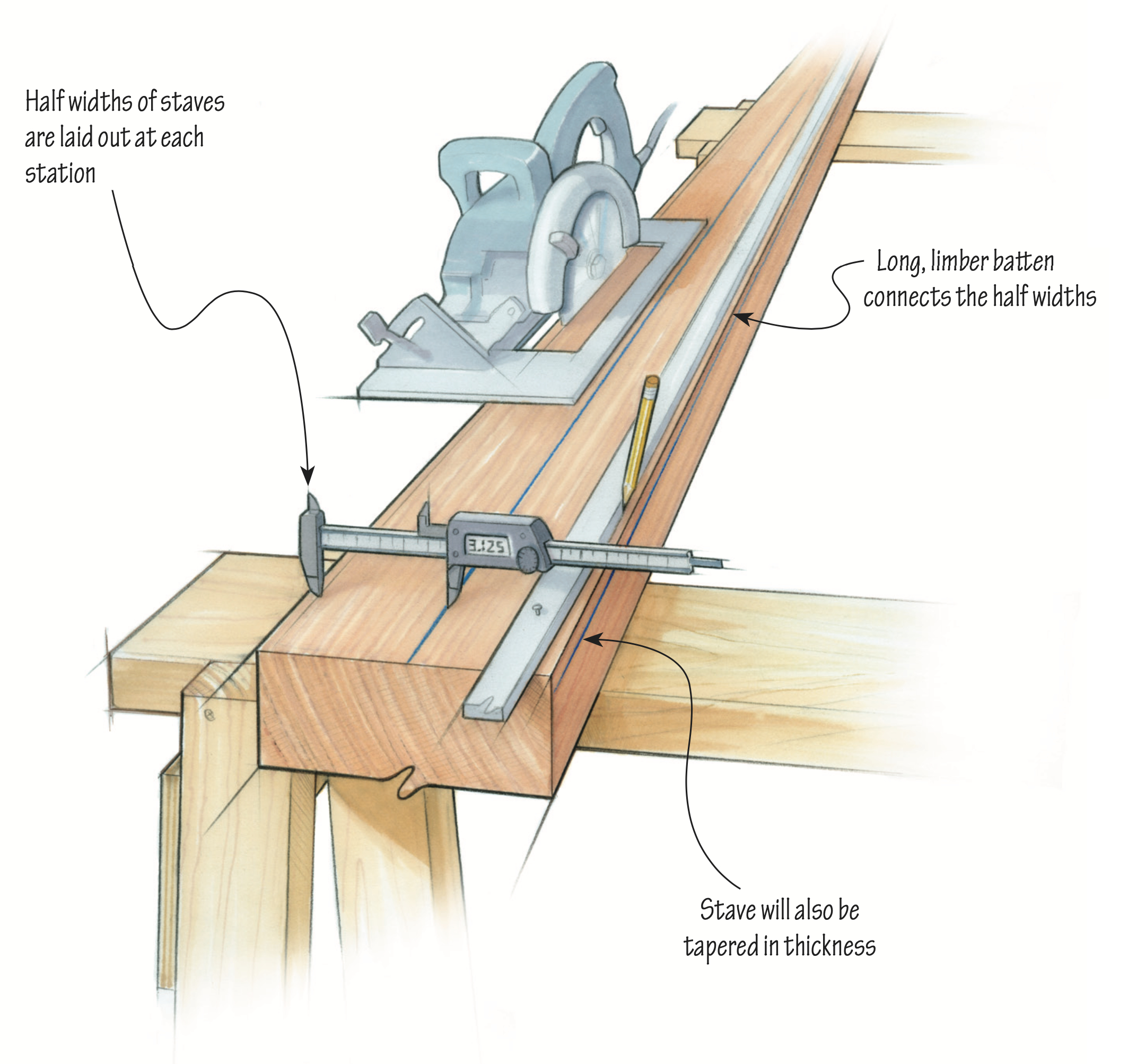
To minimize weight aloft, the wall thickness diminishes as we progress up the mast. Once again we turned to the lauan templates on which we’d recorded the wall thickness at each station. Using digital calipers, we recorded on both edges of each stave the wall thickness at each station and connected the dots with our long batten.
This line, yet to be cut, is shown in the drawing. The stock was removed from the outside faces of the staves, the bulk of it with a power plane. The final cleanup was completed with a bench plane.
Rabbeting the Forward and After Staves
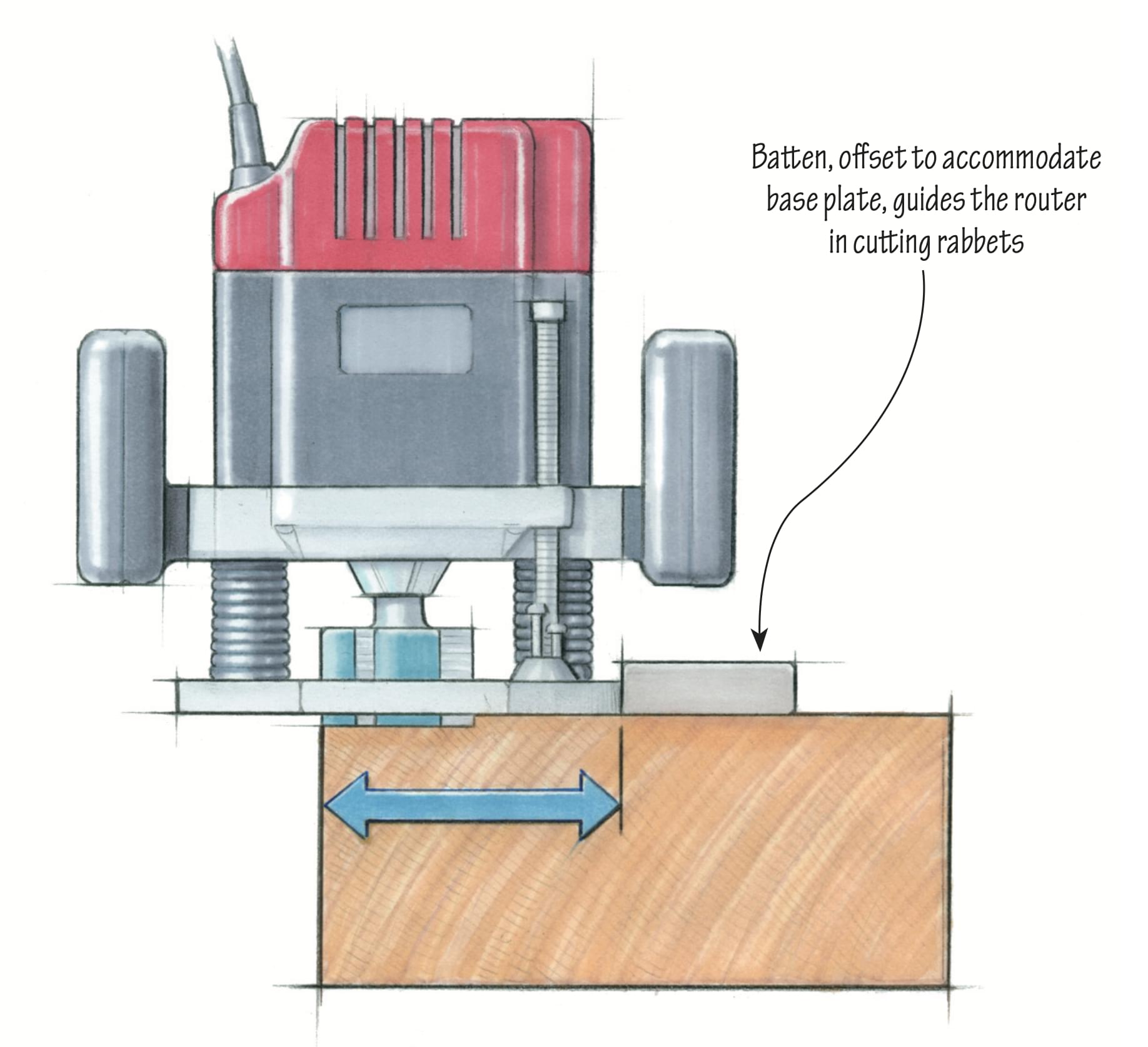
Hollowing the Forward and After Stave
The final step before gluing the staves together was to hollow out the forward and after staves. On the lauan templates we referred to the inside profile shapes we had recorded from the mast drawing. Dividing the inside profile into 1⁄4″ sections, we measured and recorded the depth at each section. We did this at each station. The inside face of the stave was thus lined off in 1⁄4″ increments.
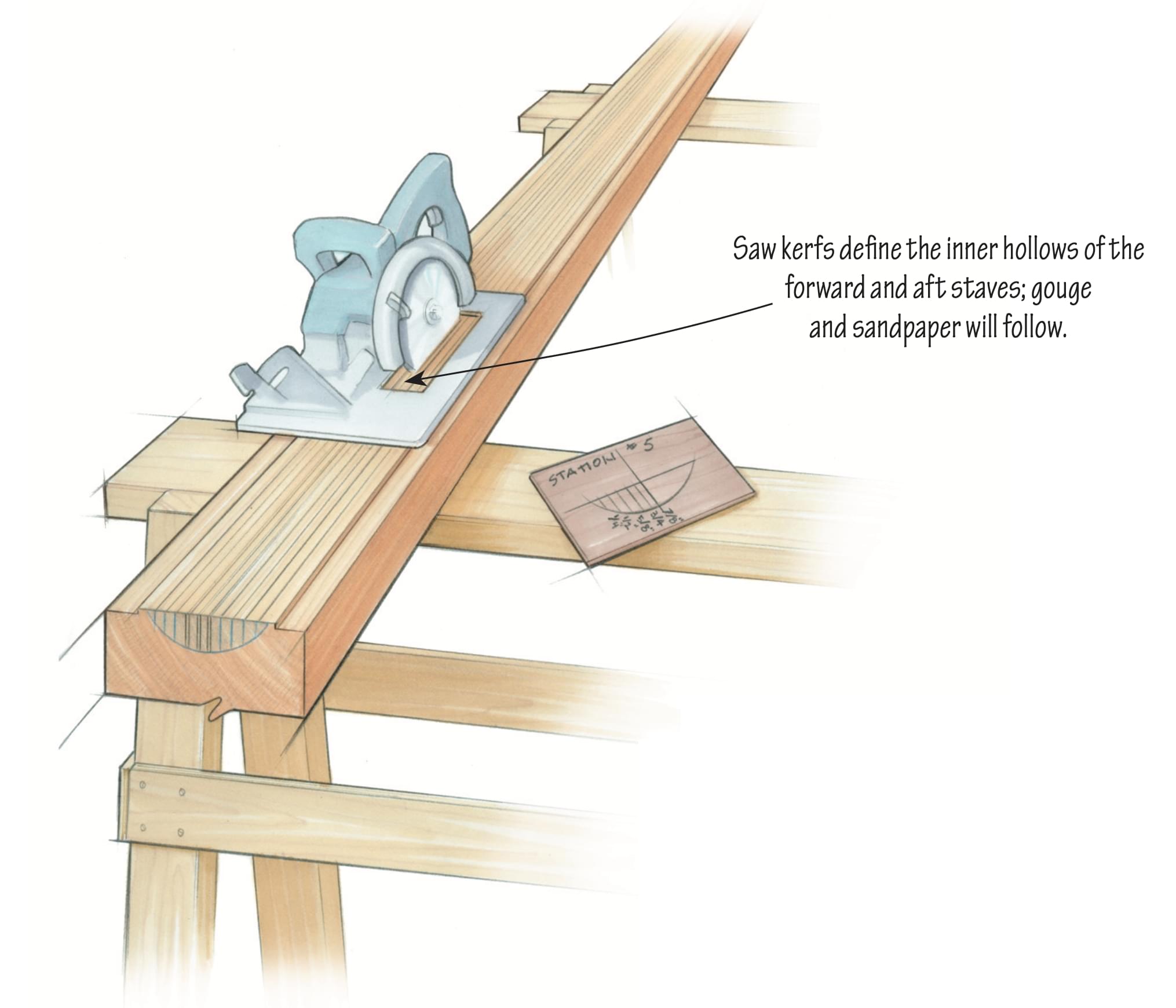
Then, using a circular saw set at the depth indicated by the lauan template, we cut kerfs in the inside face of the stave. With each pass of the saw, we reduced the depth of the cut as we moved toward the masthead and farther from the center of the stave. With the kerfs completed, we used a gouge to scoop out the waste. We arrived at the final shape by using a backing-out plane followed by 80-grit sandpaper on a round sanding block.
With the staves cut to their profiles and tapered in thickness, and the forward and after staves rabbeted and hollowed, we double checked that the spar bench was still straight. The next step was to lay the after stave on the bench, sail-track side down, and hold it straight with blocks screwed to the bench so the spar could not move. We then did a final dry-fit of the three remaining staves to make sure all joints were tight.
When satisfied with the bench and the joints, we began mixing glue. A large spar such as this takes about four people to glue up; any fewer, and panic would certainly ensue. The glue-up seems to work best as a two-step process. The first step was to glue the side staves to the after stave, using the forward stave as a dry-fitted guide to ensure that the side staves remained parallel. We clamped the spar in 1′ increments, checking that it remained square along its entire length. Using the two-step process allows ample time to fit and install the solid blocking at the head and heel of the mast. The drawing calls for blocking in the bottom 11′ of the spar and in the top 2′ 6″.
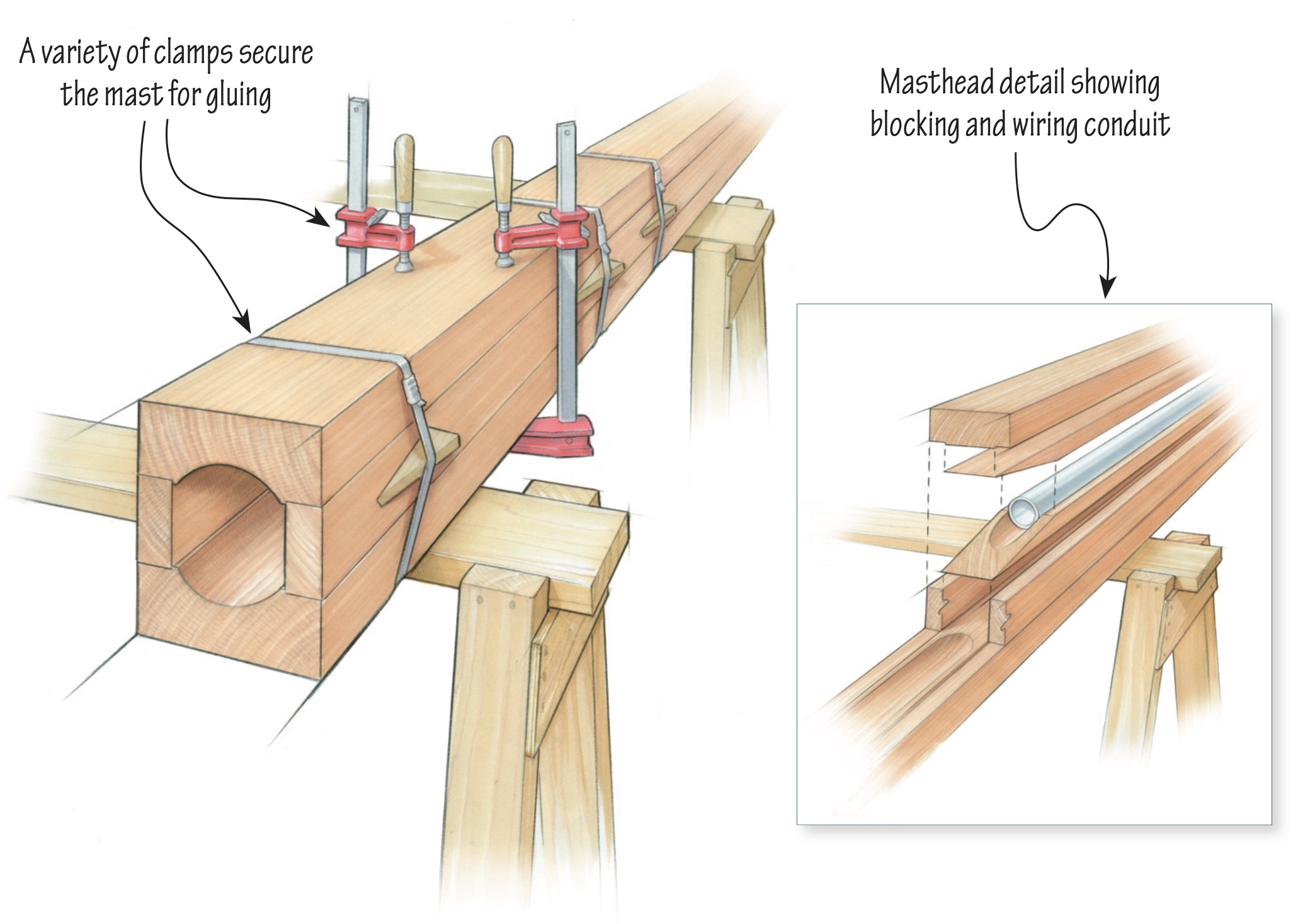
The blocking is solid until about the final foot, where it tapers to a feather edge on either side of the spar, forming a swallow-tail shape to avoid a hard spot. This heel blocking has a drain hole, in case of water intrusion. There is no blocking at the spreaders; instead, the spreaders have an external bracket and blocking system that transfers the load evenly to the spar.
We coated all interior surfaces with epoxy. At this stage, we also ran all of the wires inside the mast, securing them with large cable clamps. (Conduit fastened securely along the interior of the spar—and through the blocking—works well for this, too.) When everything was satisfactory inside the mast, the forward stave was glued to the side staves to cap the assembly. Several varieties of clamps can be used when gluing up a spar: spar clamps, bar clamps, C-clamps, or a banding tool. We used a combination of clamps and a banding tool supplemented with wedges to further tension the plastic band.
With the glue cured and the clamps off, it was time to begin the shaping process. The first step was to plane off the excess glue. With that done, we again turned to our handy lauan templates and began the process of eight-siding the spar. Using the exterior cross-section drawn on each template, we found where a 45-degree line would be tangent to the mast’s outside surface at each station. We transferred these points to the spar, and with the long batten connected them with fair lines.
We then set our circular saw to 45 degrees and made a cut, just leaving the line. Repeating this on all four sides of the mast, and then fairing up the saw cuts with a power plane followed by a hand plane, yielded an eight-sided spar. We then lined the spar off again to 16 sides, but this time we omitted the circular saw and removed the waste with only a power plane. When we had the spar 16-sided, we finished the rounding and fairing with hand planes and a custom-built concave fairing board. Once again our lauan templates came into play, as we used them to confirm the correct shape at each station. Two other details that had to be considered at this stage were the shape of the heel of the spar, and the masthead detail.
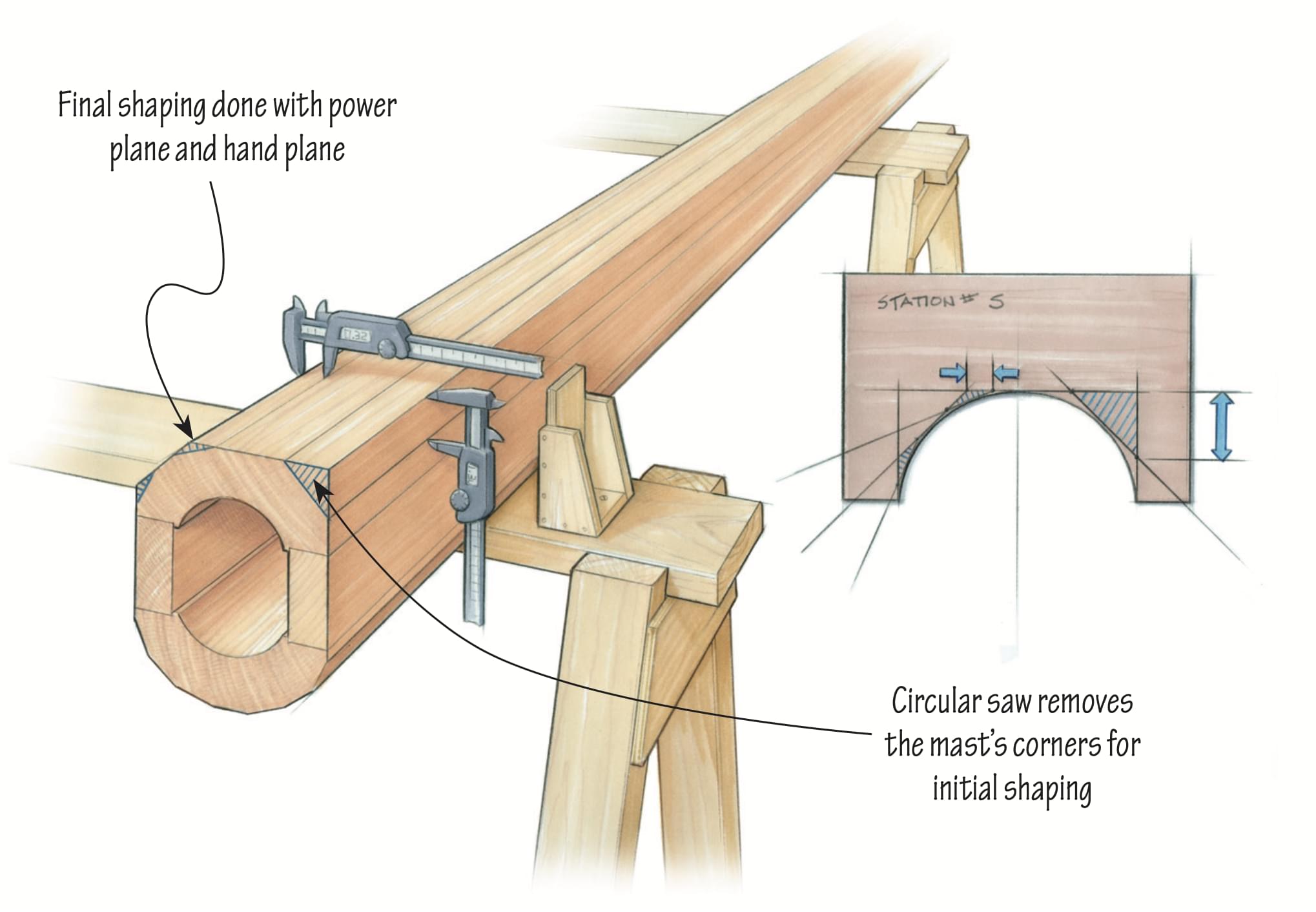
With the mast now shaped and sanded, we broke out the varnish and applied 10 coats before installing the track and hardware. We were fortunate to have all of the original tangs and other fittings for this spar, because fabricating them would have required quite a bit more work. With the spar varnished the hardware was installed, carefully bedded in soft compound. We were very careful in fastening into the Sitka spruce, as it is quite soft. We chose machine screws rather than wood screws for mounting the winches and the boom gooseneck track—after testing these fastenings on offcuts to find the best pilot-hole diameters.
This article was originally published in WoodenBoat No. 214, May/June 2010.
Related Articles
Building an amesbury skiff – part 2. planking and finishing, virginia park, building a classically inspired ship’s wheel, the marvelous oscillating multitool, related videos, greg rössel, carvel planking, part 4: common boat fastenings, carvel planking, part 2: spiling, related book chapters, a smooth and fair hull, ribbands and timbering out, deck framing, the ballast keel, subscribe for full access.
Flipbooks are available to paid subscribers only. Subscribe now or log in for access.

01865 341277


The finest masts, oars
& sculls for over 90 years
90 Years of Hand Crafting Wooden Oars, Mast and Spars
Collars have been in the business of providing rowers and sailors with specialist equipment for over 90 years. From our early beginnings in a Thameside boathouse in 1930's Oxford, making oars and sculls for the colleges, to our present involvement with large international yacht projects, the name Collars speaks of quality and tradition.

Using traditional tools and skills all our products are crafted using the same manufacturing methods passed down through three generations of time served craftsman allowing future generations of yachtsmen to enjoy and cherish.
Every mast or spar we produce has three generations and several working lifetimes of experience and expertise poured into making it.
Collars the number one choice time and time again.
Craftsmanship Guaranteed

The logical progression into wooden masts
Over the years Collars' spars have been used in Olympic competition, crossed all of the worlds Oceans, and can be found on nearly all wooden sparred production boats ever made. With a capacity of producing any wooden mast or spar up to 100' in length.
Making the finest Oars and Sculls since 1932
Having made our name in producing the finest quality wooden rowing oars for crews throughout the world, it is hardly surprising that we are still producing a comprehensive range today. Using the skills from three generations of the Collar family, a pair of Spruce spoon or skiff oars can be produced individually to the customer's requirements.
Quality is never an accident!
It is always the result of intelligent direction and skilful execution by craftsmen who care!

Bespoke Flag Poles
Whether looking to replace an historical flagpole, or raising a celebratory flag, our pedigree in producing the finest quality wooden masts for over 90 years makes Collars the obvious choice for making any flagpole.
Below is a small selection of the some of projects we have been proud to be part of in recent years.

50th Anniversary Collectors Issue - September/October Issue No. 300 Preview Now
Rotating Wing Masts—Part I
By reuel parker.
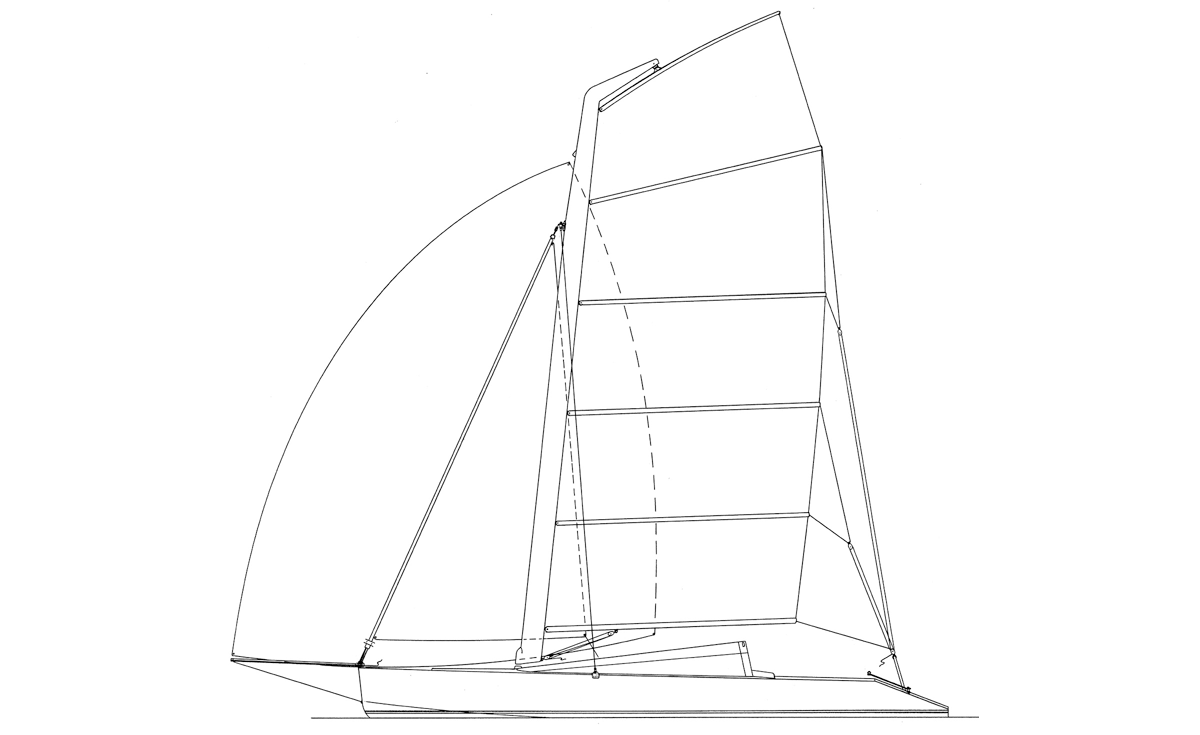
Conch 32 Sail Plan
In the late 1990s it occurred to me to design a trailerable one-design racer. I was living in Key West, and I also saw this as a way to get involved in Key West Race Week, a fairly major event in the world of fast sailboats.
Most small one-design racers have fin keels and require custom trailers, necessitating the use of a crane or Travel Lift to launch and haul them. Without very much knowledge or experience with one-design classes or rating rules, I simply dove into the project. I figured that one-design boats primarily race against each other, so I could design what I wanted… and I had a lot of ideas I wanted to try.
I designed the boat and rig during winter of 1997-8, but didn’t get around to designing the mast until early 1999. I named my design CONCH 32, after the giant, tasty undersea snails indigenous to most tropical and subtropical waters (including the Florida Keys). “Conch” (pronounced “Konk”) is also the knick-name for people born and raised in the lower Keys. Long-term transplants, like myself, who become faux “natives” are referred to as “fresh-water conchs”. The name seemed appropriate for a one-design class designed specifically to be raced in the Florida Keys. Also, my office and boat shop were located in the old Singleton sea food packing plant, which had recently been sold, and re-named The Conch Farm. We built a number of boats there, including the prototype Commuter 36 MAGIC, the three 28′ Swansea Pilot Schooners GLANCE, FRANK and SYLVIA, plus numerous small dinghies and sharpies.
I was hoping that the new owners of the property would endorse my new one-design class as a promotional gambit—perhaps even to the extent of financing one or two boats. Although they seemed excited about it at first, nothing ever happened.
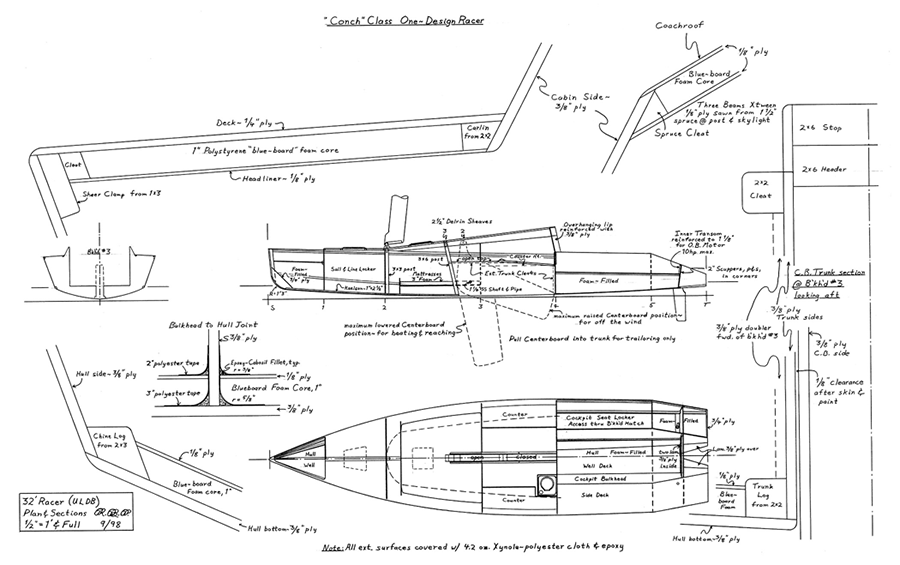
Plan & Construction Sections for the Conch 32.
To make the boat as light as possible, I incorporated polystyrene insulation foam in the hull and decks (Dow “blue-board”, which glues well with epoxy). The hull bottom is tortured marine plywood, arc-bottomed aft and V-bottomed forward. Beam is 8′ 6″ and displacement is 4,400 lbs, making this a trailerable boat. The NACA 0009 foil-shaped centerboard contains lead shot and polyester resin, and becomes a ballasted fin keel in the down position. The twin rudders are also foil-shaped.
The most unusual feature of new my hot-rod sailboat design was her mast. Rotating wing masts are very common in Key West, which is populated by a large number of charter catamarans (called “cattlemarans” locally). From studying and sailing on the big cats, I was intrigued by their rotating wing masts, and wondered why you never see them employed on mono-hulls… so I decided to try it myself.
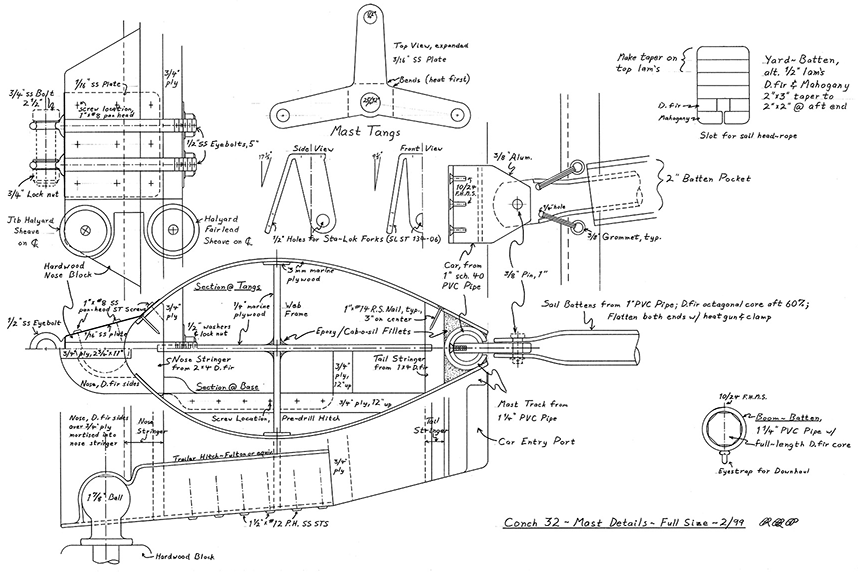
Construction Details for the Conch 32 lower mast.
Part of my concept for the Conch 32 was that she be easy and inexpensive to build—no exotic hardware! The few stainless steel components required can be made by a resourceful home-builder with a mini-grinder and bench vise. Mast track, sail-slides and sail battens can be made from standard PVC plumbing pipe and aluminum flat stock. The mast step ball joint employs a standard trailer hitch (a method used by several of the big charter cats). Sheaves use standard Schaefer Delrin replacement parts available from any chandlery or catalogue.
The idea behind rotating wing masts is that the mast fairs into the sail, like a real wing, instead of the sail coming off what is frequently the wrong part of the mast. Visualize a mains’l attached to a mast track on an oval-shaped mast while beam-reaching, and you get the picture. The mast becomes a flat block, contributing nothing but turbulence to overall sail shape. With a teardrop-shaped wing mast that is free to rotate, the mast acts like the foremost bones in a bird’s wing, or the leading edge of an airplane wing. It contributes to sail shape, rather than detracting from it. Many racing multihulls employ a “mast tiller” to further control the juxtaposition of mast to sail. This device is attached to the mast base, with control lines leading to the cockpit, allowing fine-tuning of mast/wing shape.
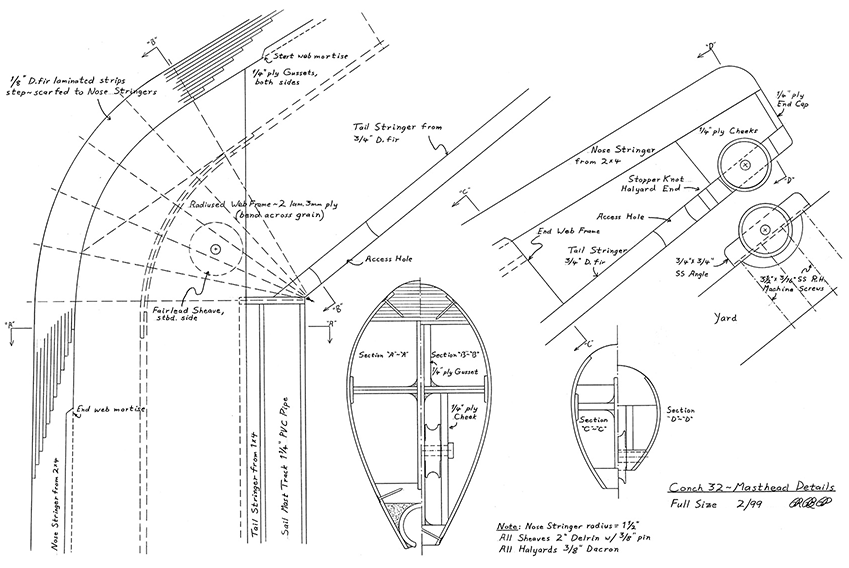
Construction Details for the Conch 32 upper mast.
This gave me the bright idea to put the mast tiller at the head of the mast, allowing the sail to automatically orient the mast optimally to the sail. I named my invention the “L-HEAD MAST”. I was also aware of a relatively new trend in sail shape, employing full-length sail battens near or even in the head of the sail. This creates a “Bat-Wing” effect, a trend which has become even more common today, fifteen years later. Some of these new sails even look suspiciously like gaff-riggers, although they aren’t! I might mention here that bat-wing sails have been commonly used on canoes, kayaks and wind surfers for many years.
I wanted my new mast to be as simple as possible, but I had to find a way to make a structural bend near the top, to form the “L-head”… this I achieved with a stepped laminated nose stringer, and pie-shaped skin sections in way of the bend. I designed a mast core consisting of an internal plywood web frame coupled to solid stringers fore & aft. The mast can be made using nothing more exotic than a table saw. I used the web frame compartments for internal halyards, mounting sheaves in integral boxes. I eliminated the infamous “Jesus Shackle” (responsible for numerous dismasting accidents) in favor of standard SS eyebolts and a custom-made tang.
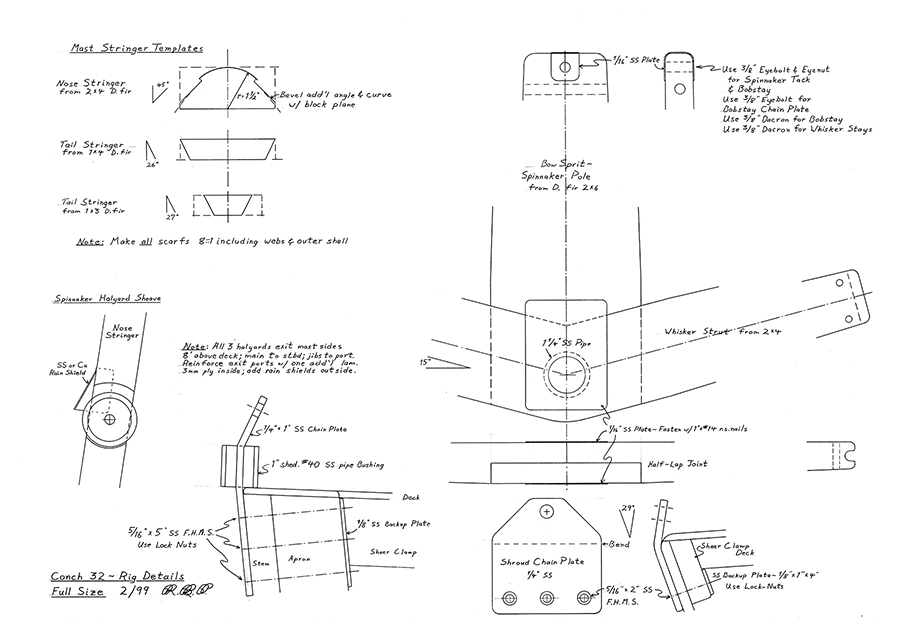
Rig details for the Conch 32.
I also designed a pivoting “bow sprit/spinnaker pole” for attaching a spinnaker tack, allowing the spinnaker to be shifted to windward on a broad reach, out from behind the mains’l.
Despite all the thought and design work I put into this project, it went over like a lead balloon! I have never sold a set of plans for the Conch 32, and one has never been built. I later designed a Conch 19 (a smaller version of the 32), and that one, also, vanished without a trace.
During this time I was avidly studying the Chinese Junk rig, which is where full-length battens for sails originated, and I began to see correlations between Junk sails, lug-rigged sails, full-length battens and multiple sheet leads. My sail plan for the Conch 32 combines various techniques from various rig types spanning centuries of time, all blended together to make something new.
In Part Two on this subject, I will address larger rotating wings employing more modern techniques and hardware, as applied to both monohulls and multihulls.
Jan 12, 2014, Saint Lucie Village
ACCESS TO EXPERIENCE
Subscribe today.
Publishing dynamic editorial content on boat design construction, and repair for more than 40 years.
1 YEAR SUBSCRIPTION (6 ISSUES)
Print $39.95, digital $28.00, print+digital $42.95, from online exclusives, whiskey plank.
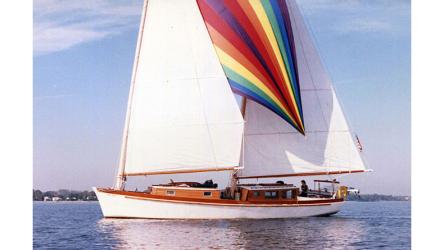
My Six Cruising Sailboats—#2 TERESA
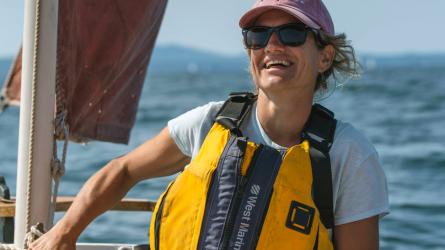
WoodenBoat Live with Arista Holden
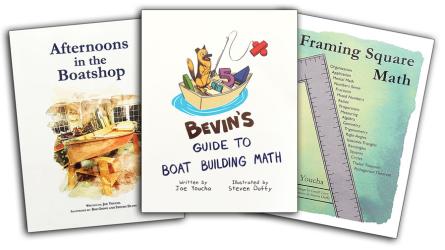
Three Books for the Young Builder’s Shop
Extended content.
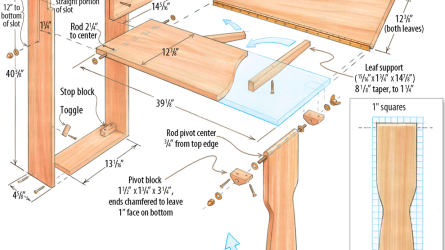
K. Aage Nielsen Table
From the community.
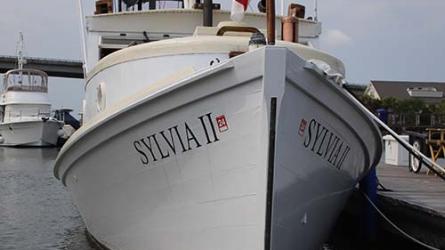

Historic NC Core Sound Sharpie
Built in 1933 as a commercial fishing vessel ,Sylvia II was designed as a deadrise Core Sound sha

44’ Pilothouse ketch
1952 EF Elkins. Major restoration and upgrades during last twenty years .
Melody Class Pram
Melody Class Pram. 10’x4.25’. Stunning craftsmanship, nearly new.

American Traders 13’ cedar canoe NEW
Beautiful American Traders 13’ Seneka cedar canoe in brand new condition.

A Perfect Fit: Custom Handcrafted Wood Spars for Your Boat

Quality wooden spars can be difficult to find these days. Used in the rigging of a sailing vessel as the means to carry or support the sail, other related pieces are known as booms as masts, and are used to deploy the sail and provide force resistance. Custom handcrafted spars are a rarity, representing another example of things not being the way that they used to be. Mass produced parts for sailboats are the use of metals like aluminum and carbon fiber are the norm. However, for owners of classic wooden boats, it just doesn’t seem right to put an aluminum spar on a handmade wooden vessel.
What is a Spar? In the most basic of terms, a spar is a pole that is traditionally made out of wood, however today it can be made out of other materials. It is a very tall and is used on sailing vessels for many different purposes. It can be used to carry sails, other spars, derricks, provide height for navigation lights, be a look-out position – you have likely seen them, without knowing what they were called, installed on a sailboat. Larger ships have several masts that are based in size and arrangement, depending on the style and size of the ship itself.
A History of Custom Handcrafted Spars The wooden spars that you see today in the form of a traditional New England sailboat mast, are not all that different from the custom handcrafted spars that were used centuries ago. Beginning in the 16th century, larger vessels were being built, requiring taller and thicker masts to be built than could be made from a single tree trunk. Boatbuilders began making wooden spars from several pieces of timber that came from the trunk of a tree in order to achieve the thickness and height required. Known in the day as a “made” mast instead of a “pole” mast, which was made from a single piece of wood, these spars were sometimes made in four sections, which were also called masts.
This was the normal way of making wooden spars – either from a single tree trunk or from several pieces of wood – up until the middle of the 19th century, when other materials and techniques began to be used. For example, the first hollow mast was used in 1845 on an American vessel known as “Maria,” which was 92 feet in length and was built from wood that was bound together with iron hoops, similar to barrel making. Experiments began with other methods for creating hollow wooden spars, such as two tapered timbers that were hollowed out and glued together and finally, the simple box form of creating hollow wooden spars was invented.
The Return of Traditional Wooden Spars One company has come forward to bring the art of custom handcrafted spars back into popularity. The Beetle Boat Shop, maker of the Beetle Cat, Beetle 14, skiffs and custom boats, has returned to its long history of spar building, which dates back to the whaling days. Once upon a time, these spars were built for Beetle whaleboats, whaling ships and other larger vessels. After purchasing spar making equipment from the liquidation of Pleasant Bay Boat and Spar Shop, Beetle has combined their use of quality materials and over 95 years of skilled craftsmanship, to produce custom handcrafted spars of the highest quality, using spar making in the traditional manner.
Recently, some impressive custom wooden spars have been created at the Beetle Boat Shop, including solid spars for a Beetle Whaleboat, hollow spars for the Bay Lady II commercial Schooner out of Provincetown, hollow spars for the 36-foot gaff rigged Raceabout Sloop Eleanor, a Sanford Alerion box section mast, and all of the spars, hardware and rigging for the marconi-rigged 16-foot Catboat Duck.
To learn more about the classic wooden boats and custom handcrafted spars made at the Beetle Boat Shop, give us a call at 508-295-8585. Our team can help you with a wide variety of New England sailboat mast and wooden spars, as well as other custom elements and accessories. We offer new boats, used boats, restorations, transportation, storage and more. Call today or visit the Beetle Boat Shop for yourself, which is located on Thatcher Lane in Wareham, Massachusetts.

U.S. Spars --->
U.S. Spars is your source for Z-Spars for Masts, Booms, Rigging, and all associated hardware
“ Sailing starts with U.S. Spars”

U.S. Spars is part of Z-Spars Group in France, the World’s Largest Spar Builders. Z-Spars has been supplying the sailing world with quality products since 1973. US Spars supplies quality brands like Hunter, Beneteau, Com-Pac and Performance Cruising. We would be happy to quote your mast, boom, and rigging needs.
US Spars takes pride in excellent customer service for Business or Individual customers. Please take advantage of our online ordering and fast shipping for all of your small part needs using our easy to use boat look-up to find your boat model and view a diagram with part numbers for easy ordering. For quotes on special orders please use our easy to use quote page for a speedy response.
U.S. Spars looks forward to getting you back on the water!
Questions? – send us an email at [email protected] or [email protected]
Comments are closed.
- Shopping Cart
- Quote Request
- Pipe Bending
- Product Support
- Digital Tension Gauge
- Promtional Items
- Rigging Quote Request
- Hayn Rigging
Find the parts for your Boat Model Here
- Sparring Partners
- Help Wanted
- {{>productsMenu}} Products
- {{>trendsMenu}} News & Trends
- Equipment >
- Rigging, Marine hardware >
- Wooden mast
Wooden masts
- My filters wooden Delete all
Manufacturers
- Brasker Masten (2)
- WoodSpars (14)
Application domains
- for sailboats (9) for sport keelboats
- for sailing yachts (3)
- for sailing dinghies (2)
- for multihulls (2)
Intended use
- classic (13)
- racing (10) one-design
- cruising (9)
Other characteristics
- marconi rig (5) bermuda rig
- gaff rig (5)
- sliding gunter rig (4)
- square rig (1)
& reach your clients in one place, all year round
{{product.productLabel}} {{product.model}}
{{#each product.specData:i}} {{name}} : {{value}} {{#i!=(product.specData.length-1)}} {{/end}} {{/each}}
{{{product.idpText}}}

sailboat mast BERMUDIEN
Marconi glued laminated masts manufactured by WoodSpars™ for Bermudian rigs up to 30m. The glued laminated timber used improves the performance of the material. Woodspars artisan manufacturing site located ...

sailboat mast AURIQUE ET HOUARI
... CONSTRUCTION OF WOODEN MASTS Constructions up to 30 meters ! A marine carpentry shipyard perfectly suited for work on wooden spars. Broken masts , damaged booms, gaffsaddless, ...

sailing dinghy mast BERMUDIEN

sailing dinghy mast AURIQUE et HOUARI

sport keelboat mast AURIQUE ET HOUARI

sport keelboat mast BERMUDIEN

sailing yacht mast BERMUDIEN

sailing yacht mast AURIQUE ET HOUARI

multihull mast Bermudien

multihull mast AURIQUE/HOUARI
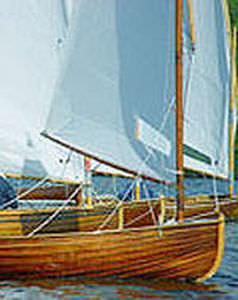
sailboat mast ONE DESIGN
Brasker Masten produces wooden spars for the following classes: • 12 voets jol • 16 m2 • 22 m2 • 30 m2 • DN • Finnjol • Flits • Flying Junior • Olympiajol • Pampus • Regenboog • Schakel • Sharpie • Spanker • ...

sailboat mast
Brasker Masten produces wooden spars for classic sailingyachts. That varies from small open wooden boats to big sea sailing schooners.
Your suggestions for improvement:
Please specify:
Help us improve:
Receive regular updates on this section.
Please refer to our Privacy Policy for details on how NauticExpo processes your personal data.
- Marine upholstery fabrics
- Snap shackles
- Mooring cleats
- Standing rigging terminals
- Shackles for sailboats
- Manufacturer account
- Buyer account
- Our services
- Newsletter subscription
- AboutVirtualExpo Group
Open for Retail and OEM/Rigger Sales! Check out the updated Dwyer Mast catalog and order online today.

Aluminum Sailboat Mast & Boom Extrusion
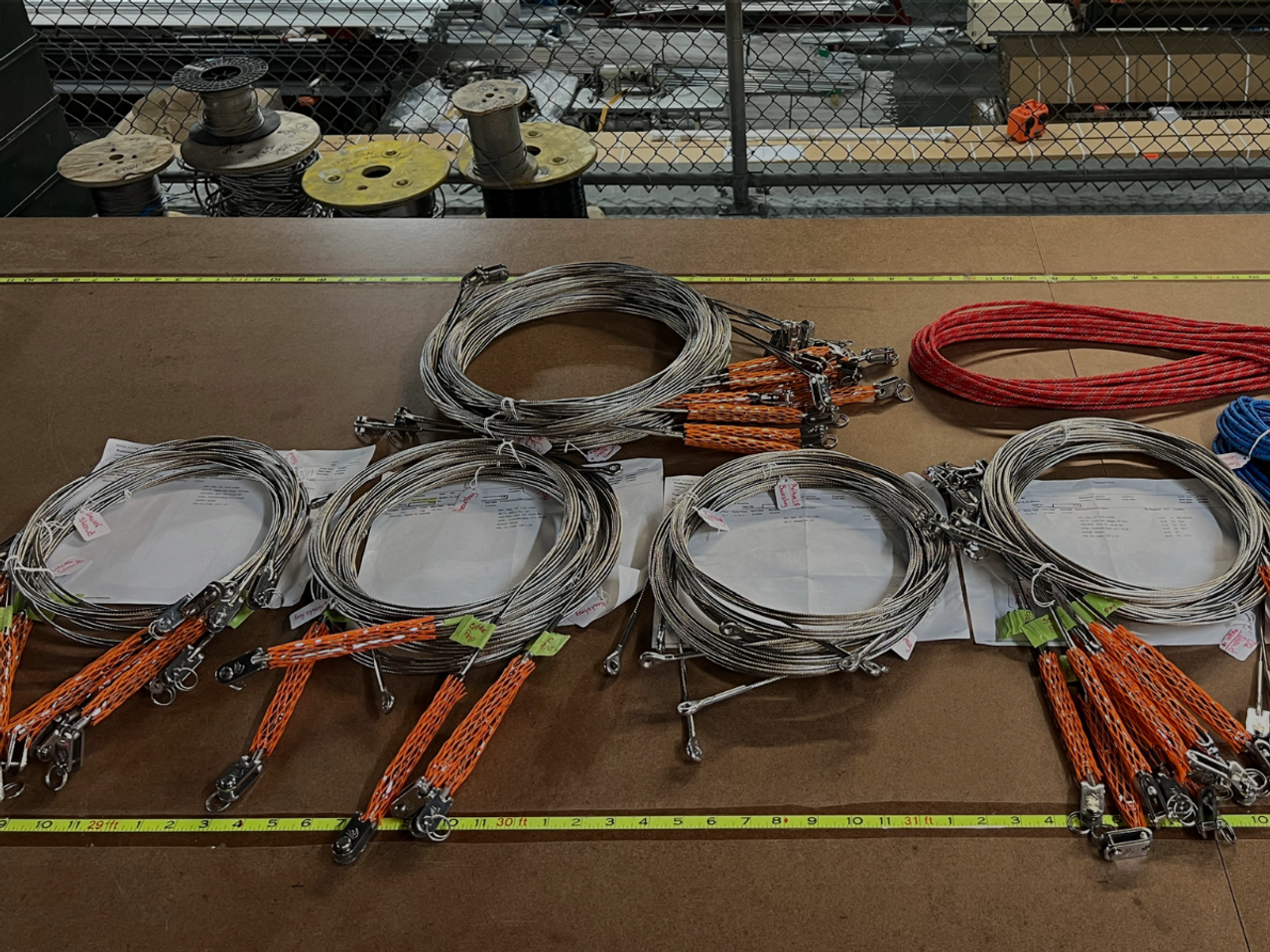
Travel Tips to Kabardino-Balkaria: More than Mt. Elbrus!
If you’ve traveled to the North Caucasus before, there is a good chance you’ve already been to Kabardino-Balkaria, and you didn’t even know it! Kabardino-Balkaria lies in the center of the North Caucasus region, is home to Mt. Elbrus, but more than that is a treasure chest of travel possibilities. Here is our guide to traveling through the republic of Kabardino-Balkaria, or 9 travel tips to this beautiful land:
1. How do I get there?
Kabardino-Balkaria hosts a large number of both foreign and Russian travelers every year, and has an improving infrastructure able to handle the incoming masses. Let’s start with the obvious. You might be a mountain climber or skier coming to enjoy the slopes of Mt. Elbrus. That means you’re likely arriving on an airplane to Russia. Here are your travel options:
A. Plane – We advise you fly into the Mineralni Vodi (MRV) airport in the Stavropol Region, which is about 45 minutes from the border of Kabardino-Balkaria. MRV is the largest airport in the North Caucasus, and has daily direct flights to and from all 3 airpots in Moscow (SVO, DME, and VKO), direct flights from St. Petersburg, and several international flight routes as well, including from Istanbul, Dubai, Greece, Tel Aviv, and Bishkek. The MRV airport has a growing infrastructure and is the most obvious choice to fly into if going to Elbrus. From MRV, it’s a 2 hr. drive to Nalchik, and a 3.5 hr. drive to Mt. Elbrus.
That being said, the capital of Kabardino-Balkaria, Nalchik (NAL), also has a small regional airport with a daily flight to/from Moscow as well as weekly flights to Istanbul. As is to be expected in most smaller, regional airports around Russia, the service standard at a small airport like this will be minimal. As a result, we recommend you flying in and out of MRV if able. It’s a 2 hr. drive to Elbrus from Nalchik. You can also fly into other regional airports which are 2 hrs. from Nalchik, such as OGZ in North Ossetia (Vladikavkaz) or IGT in Ingushetia (Magas).
B. Car/Public Transport – If you have a car, are using a taxi, or are hitch-hiking your way to Kabardino-Balkaria, the region is accessible by a variety of roads and vehicles. A major Russian federal highway E50 runs through Pyatigorsk into Kabardino-Balkaria, and can take you towards Mt. Elbrus, Nalchik, and deeper into the North Caucasus. There are daily mini-buses, or “marshrutkas”, that travel to Nalchik from Pyatigorsk, Vladikavkaz, Grozny, and Magas, if you’re coming from a neighboring republic. From the main Nalchik bus station, there is a marshrutka that goes to Terskol (i.e. Mt. Elbrus) daily around 12:30 pm; for that matter, marshrutkas run daily into every valley of this beautiful republic. For the seasoned international traveler, you can drive from the country of Georgia up the famed “Georgian Military Highway” through the heart of the Caucasus Mountains, cross the border into Russia at the “Verkhni Lars” border stop, and be in Nalchik in about 2.5 hours as well.
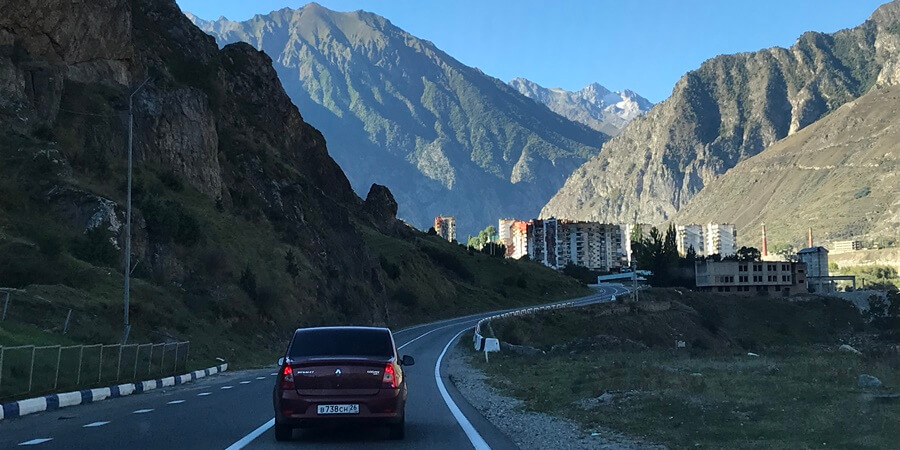
Anyone traveling on their own should download the “Yandex” taxi app, which is Russia’s version of Uber, and has a very user-friendly app with affordable prices. In smaller villages/towns where Yandex’s service doesn’t reach, just ask a local and they’ll direct you to a friend or relative who can taxi you where you need to go!
C. Train – Kabardino-Balkaria is also very accessible by the famous cross-country Russian train system if that’s your preferred method of travel. Almost all trains to the North Caucasus pass through Mineralni Vodi in the Stavropol region to the north, so make sure wherever you are coming from, Mineralni Vodi is one of the stops. Despite Nalchik having a train station, the city is about 45 minutes from the main railway route that runs diagonal through the North Caucasus, and as a result it’s a bit convoluted to get a train directly to Nalchik. That being said, the town Prokhladni is a regular stop on trains going to/coming from Baku, Makhachkala, Grozny, Nazran, and Vladikavkaz, so you can always hop off there and find your way by public transport or taxi.
2. What are the best places to stay?
This list could get exhaustive, fast. 🙂 Let’s first look at an overview of the republic’s geography, followed by hotel recommendations:
A. Nalchik – This is the capital city of Kabardino-Balkaria, with a population of around 250,000. Nalchik is growing and new, modern hotels are being built regularly. Here are some of our recommendations:
-Modern and comfortable: Azimut , Butik Otel
-Budget with less frills: Hotel Rossia , Korona
You could comfortably spend a week in Nalchik, while doing day trips into Kabardino-Balkaria’s beautiful mountain valleys.
B. Baksan Valley – This is the most traveled road in Kabardino-Balkaria, the road to Mt. Elbrus. If you have questions about its safety because of travel warnings, please see our detailed blog here of the drive to erase any doubts or fears. Needless to say, because of the draw of Mt. Elbrus, there are a huge variety of lodging options at the end of this valley, from 4-star to mid-range to budget to hostel. Here are just a few we’ll recommend from our experience:
-Modern and comfortable 4-star-ish: Azau Star , Kristall 139
-Budget with less frills 3-star-ish: Laguna , Povorot
If you’re a mountain climber with your sites set on the summit of Elbrus, you’ll have to spend at least 3-4 nights at Elbrus’s famous base camp at 13,000 feet. The “barrel huts” are not easy to book directly with, and we highly recommend you do your climb (and hence, have your bookings handled) through a trusted climbing company. Here are two shelters at base camp we recommend:
-Modern and comfortable: Leaprus
-Budget with less frills: Heart of Elbrus Lodge
If you’re interested in climbing Mt. Elbrus and staying in these barrel huts, click here to see our climbing itineraries, pricing, and group dates.
C. Chegem Valley – Chegem Valley is the adjacent valley to Elbrus’s Baksan Valley, and is famous for its beautiful waterfalls as well as being Russia’s top paragliding location. The “ Paradrome ” has modest accommodations for those wanting to get to know this beautiful valley for a longer period of time.
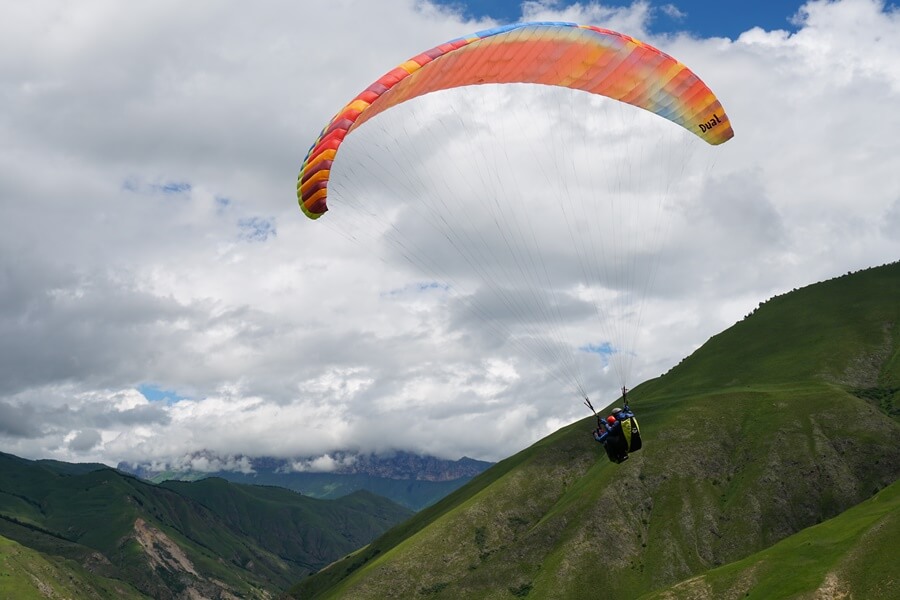
D. Upper Balkaria, or Cherek Valley – This is another beautiful mountain gorge not too far from Nalchik. There is an authentic lodging complex in Upper Balkaria called Tau-El, with amazing local food for meals as well.

E. Border Zone lodging – Several of Kabardino-Balkaria’s mountain gorges run into the border zone with neighboring country Georgia, i.e. an area that foreigners cannot enter without a special permit from the local government (often taking 2 months to receive). There is a famous mountaineering lodge in Bezengi Valley, where several generations of Russian mountain climbers have honed their craft in the Caucasus Mountains. Perpendicular to Baksan Valley (about 25 minutes from the base of Mt. Elbrus) is Adyr-Suu Valley, where there is a lodge for back-country skiers to stay, while trying their hands (and feet!) on the untouched snow of that valley. Both these valleys require border permits for foreigners, but are possible to access for the more adventurous!
3. Top cities to visit?
Most locals would agree that Nalchik is the main city of significance to visit in Kabardino-Balkaria, but let’s be honest, even more would say, “Just go to the mountains!” Tirnauz is the capital of the Elbrus district, and is an interesting town to spend some time in, with its unique location in the mountains and place in Soviet history as a once-booming mining town. The main thing to consider in visiting Nalchik and other cities in the lowlands, is the chance to experience Kabardian culture and food. Whereas the deeper you go into the valleys, the more you’ll encounter Balkar culture and food.
4. Best local foods to try?
There are 3 types of food that come to mind, when spending time in Kabardino-Balkaria:
A. Khychiny – This is one of the staple national dishes of the Balkar people, and what you’ll inevitably be served if guests of local Balkars. It’s a thin buttery flat bread, sometimes cooked with fillings of cottage cheese, fresh greens, or potatoes. It is often slathered in butter, but wow is that some tasty greasy goodness! 🙂

B. Shashlik – Shashlik is a MUST for any visit anywhere in the North Caucasus! Most people would agree that it’s the national food of the entire region. Shashlik is meat shish kabobs; while pork and turkey can be found in some parts of the Caucasus, lamb or chicken are the preferred shashlik meats of choice in Kabardino-Balkaria.
C. Soup – No matter where you are in Russia, you’re sure to find a local soup that people love. Kabardino-Balkaria is no different. Especially in the winter months in the mountain valleys, there’s nothing better than to come inside from the cold weather and warm your body up to a bowl of hearty Caucasus soup. Whether Georgian kharcho or local Balkar lakhman, make sure to try your hand at one of these soups with a side of fresh baked bread/lavash!

5. Top Hole-In-The-Wall restaurants:
Of course, for a republic of this size, we’re bound to leave at least a few great local joints off our list, but here are a few to get you started. ***Note: Restaurants in the North Caucasus are much better known for their food than their service, so prepare for tasty food, but manage your expectations about service:
-Elbrus – Kogutai Restaurant at Mt. Cheget – While this isn’t a hole-in-the-wall restaurant per se, it’s one of many to choose from in the Cheget tourist village, and we have found them to provide consistently good food and service. Kogutai has a nice interior, and maybe most important, an English-language menu with good pictures. 🙂 There also is a nice outdoor patio with fantastic views of the surrounding mountains.
-Nalchik #1 – Tameris Restaurant – This is a cafe with a relaxed atmosphere in the capital Nalchik. Local tour company Elbrus Elevation has taken foreign groups there on multiple occasions and always had good experiences. Address is ul. Kuliyeva 3.
-Nalchik #2 – Cafe-Bar Oasis – You have to know where this restaurant is to find it, but once inside, you won’t regret it! There is a unique cafeteria-style ordering process, that includes several dishes being cooked on the spot once ordered. You can sample local Kabardian dishes here. The seating area is very modern and a pleasant atmosphere to have a meal in. Address is ul. Kuliyeva 2.
-Upper Balkaria – Tau-El Restaurant – This is the restaurant part of the Tau-El Tourist Complex in Upper Balkaria. Whether spending the night or just passing through, make sure to stop here for a meal!
6. Must-See Sites
This republic is so chock full of “must-see” destinations, it’s impossible to narrow the list down. Here are just a few suggestions to get you started: (***Mt. Elbrus is a no-brainer and we’re assuming that’s on your list)
A. El-Tyubu and Paradrome – This is an amazing area towards the end of Chegem Valley. Many tourists visit the famous Chegem Waterfalls and don’t drive any further down this gorge, which really is a shame. El-Tyubu is a picturesque Balkar village with several historical sites to see, including some ancient mausoleums. The real gem of the area, though, is the Paradrome , which is Russia’s premier paragliding destination. The combination of the scenic surrounding mountains and constant winds produces almost daily conditions to sail through the beautiful Caucasus sky. Highly recommend!
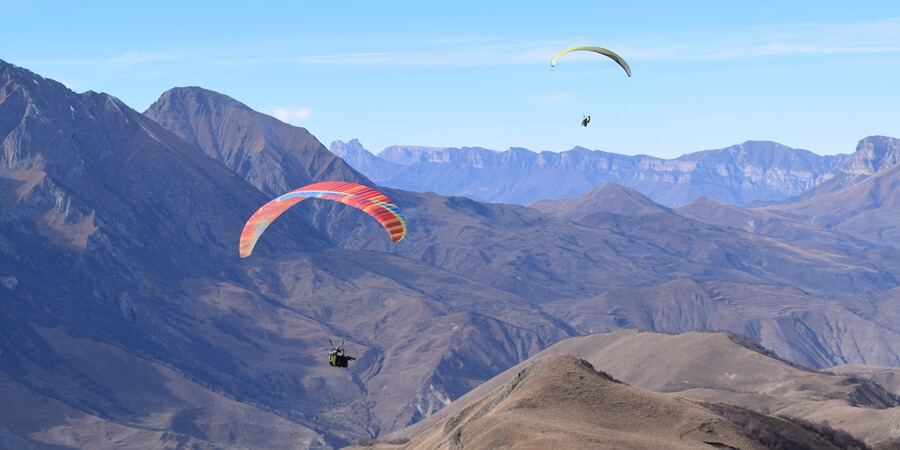
B. Upper Balkaria – Also known as Cherek Valley, the entire drive to the actual village of Upper Balkaria is one big destination. First, you can spend time at the 3 consecutive “ Blue Lakes ”, one of which is one of Russia’s deepest lakes with an underground spring. Then, the drive itself becomes an adventure, as you pass by steep rock walls with a huge drop-off on the other side. If you’re able to walk this part of the road, that is a bonus! Once you’ve made your way through the valley walls, the region opens up into a beautiful panoramic view. Many years ago, there were multiple villages in this region, but they’ve since been condensed into one main village. You can see some of the ancient Balkar towers that their ancestors used to live in as well.
C. Djili-Suu – Although hard to pronounce and not easy to get to, Djili-Suu is one of those places in the North Caucasus that people rave about that you “have to” visit. It’s actually on the North side of Mt. Elbrus, and more accessible from the Mineral Waters region (2 hrs. from Kislovodsk). The base camp for Elbrus climbers summiting the mountain from the North side is at Djili-Suu. This area is famous in Russia for its numerous natural healing springs, as well as unique climate conditions that make for beneficial, long holidays for seeking a respite from their daily grind. There are wide swaths of land available for camping, with probably the most unrivaled views of Mt. Elbrus in the North Caucasus. Make sure to check this out!
7. Off-the-beaten path destinations

A. King’s Waterfalls (Tsarskie), or Gedmisht – Probably the valley in Kabardino-Balkaria with the least amount of hype is the Malka Valley, which is the northernmost valley and mainly runs through the Kabardian lowlands. At the point where the villages end, though (Khabas), the asphalt turns into dirt and the hills start to rise, culminating with the incredible King’s Waterfalls, or as one friend put it, Avatar Waterfalls. These stunning waterfalls are best visited in the early summer, when everything is lush green and the water flow is strong, with many streams of water flowing down the earth’s surface. The different colors are incredible and it’s hard to look away. Once you’ve enjoyed the waterfalls, enjoy a meal of shashlik at one of the nearby lunch huts. Having an off-road vehicle is ideal to visit these falls, but worth the time and effort!
B. One-seater chair lift at Elbrus – As the infrastructure at Mt. Elbrus has modernized, some of the more “authentic” experiences have gone to the way-side. This is one experience still available, though! From the 2nd (11,000 ft.) to 3rd level (12,500 ft.) of Mt. Elbrus (whether skiing, going to base camp, or just touring), there is a single-seater chair lift for 100 rubles each way (less than $2). This is an amazing experience if you have the time. It’s 8-10 minutes each way, and a surreal experience of the majestic Caucasus mountain range surrounding you, skiers silently passing you by underneath, and in general enjoying the silent expanse of nature all around. The chair lifts are from the Soviet times and so it feels like something from a different era. For mountain climbers, the newer group cable car gives better access to most of base camp, but several huts are pretty close to this chair lift, so it still may be a good option for you.
C. Abandoned Mines above Tirnauz – Tirnauz is about 1 hr. from Mt. Elbrus, and a town everyone drives through to and from the mountain. Although today it looks old and half-abandoned, it was a booming mining town in the 20th century. About a 45-minute drive above the city with an off-road vehicle, you can see the remains of the mining operations. Learning about this history combined with the breath-taking views of the Baksan Valley and even into Georgia, you’ll wonder why more people aren’t visiting this place. This is a great spot to see eagles soaring in the sky, as well as admire the Soviet city plan of Tirnauz from above.
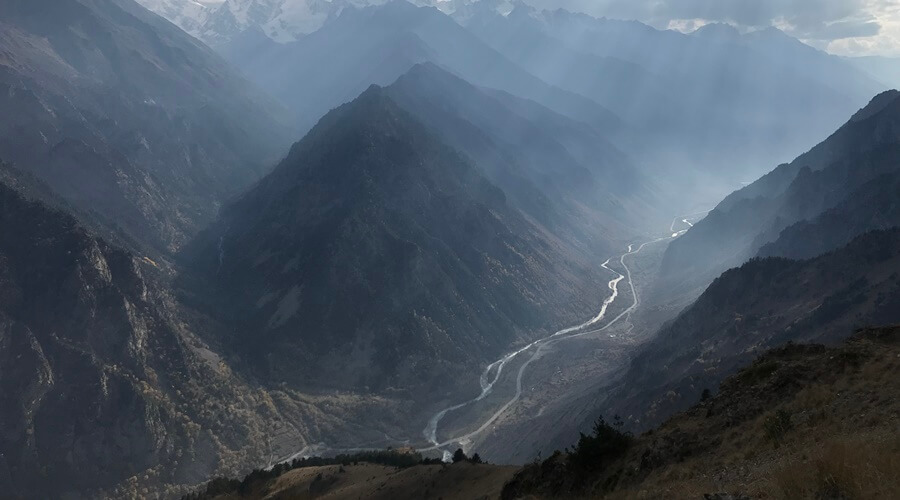
8. What do I need border zone passes to visit?
In Russia, any area within 5-10 km of a neighboring country, without a clearly delineated border (i.e. in the mountains) is considered a special border zone, and patrolled by Russian border guards. This area IS accessible to all Russian citizens with their passports, but is NOT legally accessible to foreign citizens UNLESS you have a special permit from the FSB (Federal Security Bureau). These permits are accessible, either through a tour operator or local friend, but require you to submit your application 45-60 days in advance.
Areas in Kabardino-Balkaria that are worth a visit if you have a border zone pass:
A. Bezengi Wall – This is at the end of the Bezengi Valley, and holds a place of lore among Russian mountain climbers. Many mountain guides go through training in this valley. Five of the Caucasus Mountain’ range’s highest seven peaks are a part of the Bezengi Wall, so you can imagine the draw it has for climbers. There are great areas for trekking and camping in this area.
B. Adyr-Suu Gorge – This remote valley runs perpendicular to Baksan Valley and is about 25 minutes from the base of Mt. Elbrus. It’s marked at the entrance by a relic of the past, a car lift from Soviet days that auto-cranks your car (and you) about 50 meters up the mountain. After 45-60 minutes of driving on gravel road, the gorge opens up into a flat valley with a beautiful view of the surrounding mountains. The Adyr-Suu Alpine Lodge is at the end of this valley and where back-country skiers base out of during the acclimatization phase of their Mt. Elbrus ski tours. This is truly a place where you can experience untouched powder!
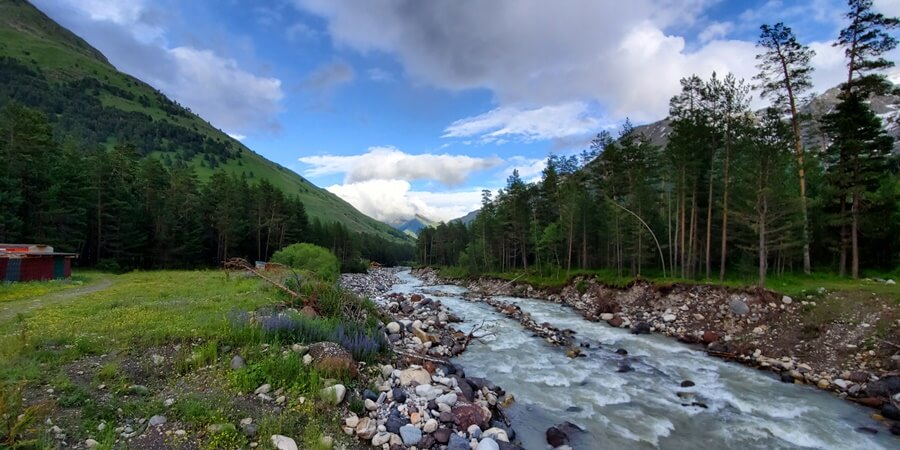
C. Mt. Cheget (Elbrus) – Cheget is a neighboring mountain to Mt. Elbrus and where many climbers will acclimatize, both at its base and while doing some hikes. It also is famous in Russia for its free-ride terrain for more experienced skiers. Standard access to the chair lifts and mountain are available to all (i.e. mountain climbers don’t need to worry about accidentally crossing into the zone), but anyone wanting to summit the peak of Cheget OR visit the beautiful Cheget Lake needs a border permit.

Foreigners violating the border zone areas is considered a serious offense in Russia; make sure to do your due diligence if wanting to visit one of these areas! We highly recommend using a local tour operator and always traveling with a local person if visiting one of these areas.
9. Any cultural “do’s” or “don’t’s” to be aware of

Kabardino-Balkaria is a fascinating republic with a combination of traditional and modern society. The more you interact with local people, the more you’ll see a mixture of Muslim faith, post-Soviet mentality, and ancient local traditions all wrapped together.
Kabardians mainly live in the lowlands (Nalchik, Baksan, and lowland villages), while Balkars primarily live in the mountain valleys (Elbrus, Chegem, Upper Balkaria, etc.). There is a large population of Russians in the region as well. Foreigners visit every area of the region regularly, and so local people are used to and will welcome your presence.
Come with an open mind to learn about these peoples, their traditions, and their land. You won’t regret your trip to Kabardino-Balkaria!

***Want to learn more? Here are several self-published resources from the podcast “ CaucasTalk ” related to Kabardino-Balkaria:
– Travel Tips to Kabardino-Balkaria (audio version of this blog)
– History of Mt. Elbrus (Part 1)
– History of Mt. Elbrus (Part 2)
– Interview with Local Elbrus guide
– Climbing Elbrus: Interview with American guide
– Who are the Kabardians? (Part 1)
– Who are the Kabardians? (Part 2)
– Skiing in the North Caucasus (Elbrus and more)
READY TO EXPERIENCE KABARDINO-BALKARIA FOR YOURSELF?
Where to find us.
- +1 704-810-4296
- [email protected]
- 1578 Pine Creek Rd., Gastonia, NC 28056
Travel Information
- We no longer offer travel services to Russia. See Caucasus Quest Tours for new destinations
- Is it Safe to Travel to the Caucasus in 2024?
- Climbing Kazbek & Kilimanjaro: Comparing two 5,000+ meter peaks
- How to Train to climb Mt. Kazbek in Georgia
Our Elbrus Climbing Tours
- Climb Elbrus South Route
- Climb Elbrus North Route
- Climb Elbrus & The Capitals
- Climb Elbrus & The Caucasus
Russia Cultural Tours
- Capitals of Russia
- Lake Baikal on Ice
- Delightful Dagestan
- Heart of the Caucasus
ALL Travel Services to Russia and Mt. Elbrus have been indefinitely suspended as of Feb. 2022.
Explore our new tour branch Caucasus Quest to climb Mt. Kazbek (5,054 meters) in Georgia or for immersive cultural touring experiences in Georgia, Armenia, and Azerbaijan.
- Womens Panties
- Mens Briefs Boxers
- Sexy Underwear
- Bra Brief Sets
- Garters Bel
- Camisoles 7983
Wedding Apparel Accessories
- Wedding Dresses
- Bridal Accessories
- Bridal Gown
Cooking Appliances
- Induction Cookers
- Range Hoods
- Rice Cookers
- Electric Deep Fryers
- Electric Grills Electric Griddles
Air Conditioning Appliances
- Humidifiers
- Air Purifiers
- Air Conditioners
- Dehumidifiers
- Other Air Conditioning Appliances
Energy Mineral Equipment
- Mining Machinery
- Energy Saving Equipment
- Gas Generation Equipment
- Oil Field Equipment
- Petroleum Processing Equipment
- Energy Saving Equipment Parts
- Gas Generation Equipment Parts
- Magnesium Production Line
Food Beverage Machinery
- Snack Machines
- Fruit Vegetable Processing Machines
- Baking Equipment
- Beverage Wine Processing Machinery
- Other Food Processing Machinery
- Grain Product Making Machines
- Grain Processing Machinery
- Baby DiapersNappies
- Baby Skin Care
- Baby Bath Supplies
- Baby Oral Hygiene
- Baby Hair Care
Hair Extensions Wigs
- Hair Extension
- Other Artificial Hair
Police Military Supplies
- Bullet Proof Vest
- Other Police Military Supplies
- Warning Tape
- Bullet Proof Helmet
CCTV Products
- CCTV Camera
- CCTV System
- CCTV Accessories
- CCTV Monitor
- Other Surveillance Products
- CCTV Camera Housing
LED Outdoor Lighting
- LED Flood Lights
- LED Street Lights
- LED Garden Lights
- LED Wall Washers
- LED Outdoor Wall Lights
- LED Underground Lights
- LED Tunnel Lights
- LED Lawn Lights
Stage Lights
- Moving Head Lights
- Laser Lights
- Beam Lights
- Scan Lights
- Cyclorama Lights
- Follow Spot Lights
- Projection Lights
- Moving Lights
Motorcycle Parts
- Motorcycle Tires
- Motorcycle Body Parts
- Other Motorcycle Parts
- Motorcycle Electrical System
- Motorcycle Engines
- Motorcycle Brakes
- Motorcycle Transmissions
- Motorcycle Wheels
- Valve Train
- Intake Exhaust Valve
- Rocker Arm Rocker Shaft
- Valve Tappet
- Other Auto Parts
- Other Auto Valve Train
- Speaker Horn
Paints Coatings
- Building Coating
- Appliance Paint
- Furniture Paint
- Electrical Insulating Varnish
- Plastic Coating
- Other Paint Coating
- Organic Fertilizer
- Nitrogen Fertilizer
- Compound Fertilizer
- Potassium Fertilizer
- Phosphate Fertilizer
- Biological Fertilizer
- Other Fertilizers
Canned Food
- Canned Fruit
- Canned Poultry Meat
- Canned Seafood
- Canned Beans
Honey Products
- Royal Jelly
- Honey Syrup
- Steel Wire Mesh
- Iron Wire Mesh
- Copper Wire Mesh
- Aluminum Wire Mesh
- Fiberglass Mesh
- Other Wire Mesh
- Aluminum Profiles
- Aluminum Sheets
- Aluminum Foil
- Aluminum Coils
- Aluminum Pipes
- Aluminum Bars
- Aluminum Strips
- Aluminum Powder
- View All Categories
- Sign In / Join Free My Account
Kabardino-Balkaria State University
Kabardino-Balkaria State University – Expo Center handling all events like exhibitions, trade shows or fairs taking place in Nalchik, Russia.
| Address | City | Country | Phone | Website | |
|---|---|---|---|---|---|
| Elbrus settlement | Nalchik | Russia |
Other Events At this Venue During 2024-2025

Other Events In Russia

Connect with Verified Buyers
Signup today to claim your Discount. Get Started before it's too late!


COMMENTS
Wooden Masts and Spars. Our wooden masts and spars are made with the same uncompromising quality and attention to detail as our oars and paddles. We have made hundreds of masts and spars for boats as small as nutshell prams, for many Herreshoff designs, and numerous larger boats like Concordia yawls. Due to our shop size, 50 feet is our maximum ...
Sailboat masts made from 4 quarters, 2 halves, hexigonal ... The WoodenBoat Community is a collection of tools and resources that allow wooden boat builders, designers, owners, would-be owners, and dreamers to interact with each other, find inspiration, and learn something new. Image. Boats for Sale Online. Buy or sell a wooden boat /boats-for ...
You can reach us at 360-532-8611 or 800-200-5239. Or email us at [email protected] . The Spar Shop at the Historical Seaport custom-builds wooden masts, yards, booms, and gaffs for sailing ships and modern large sailboats, as well as flag poles, interior and exterior single-log wood columns for premium homes, and custom-turned ...
Structural Considerations. A mast/spar needs both strength and stiffness and be able to resist fatigue. Sometimes these characteristics can be conflicting. Strength or resistance to breaking in wood involves its elasticity which allows the wood to bend to absorb stresses. Whereas stiffness is the resistance to bending.
Since 1961, RIG-RITE has engineered, manufactured and distributed Spars, Rigging and Hardware Systems for Sailboats. RIG-RITE stocks the largest variety of related Systems and Hardware available anywhere, Specializing in original replacement parts for Systems on yachts built the world over. Spars - Masts, Booms, Spreaders, Spinnaker Poles ...
1 YEAR SUBSCRIPTION (6 ISSUES) PRINT $39.95. DIGITAL $28.00. PRINT+DIGITAL $42.95. Subscribe. I have developed a "new" mast construction method for use on light- to moderate-displacement sailboats having a Marconi rig, and for motorsailers. I put "new" in quotes because I am sure it has been thought of before now.
Wooden Masts and Spars. Custom-made for your boat. Wooden Masts and Spars. from. $525.00. To determine the correct length oar for your boat measure the distance between the port and starboard oar sockets. Then apply the Shaw and Tenney oar length formula to determine the oar length that will provide the correct 7:18 leverage ratio.
ISLA, New York 32 No.10 (of a total of 20), was thoroughly rebuilt last year by Buzzards Bay Yacht Services of Mattapoisett, Massachusetts. The job included a new mast, whose construction is detailed on the following pages. W hen my company was hired to restore New York 32 No. 10, ISLA, in 2008, the boat had been out of service for over 25 ...
HAND MADE NAUTICAL SMALL WOOD DEAD EYE DEADEYE RIGGING SAILBOAT MAST YACHT !! Opens in a new window or tab. Pre-Owned. $45.00. or Best Offer +$5.90 shipping. Free returns. Sponsored. Extra 10% off with coupon. Top Rated Plus. Sellers with highest buyer ratings; Returns, money back;
90 Years of Hand Crafting Wooden Oars, Mast and Spars. Collars have been in the business of providing rowers and sailors with specialist equipment for over 90 years. From our early beginnings in a Thameside boathouse in 1930's Oxford, making oars and sculls for the colleges, to our present involvement with large international yacht projects ...
The hull bottom is tortured marine plywood, arc-bottomed aft and V-bottomed forward. Beam is 8′ 6″ and displacement is 4,400 lbs, making this a trailerable boat. The NACA 0009 foil-shaped centerboard contains lead shot and polyester resin, and becomes a ballasted fin keel in the down position. The twin rudders are also foil-shaped.
To learn more about the classic wooden boats and custom handcrafted spars made at the Beetle Boat Shop, give us a call at 508-295-8585. Our team can help you with a wide variety of New England sailboat mast and wooden spars, as well as other custom elements and accessories. We offer new boats, used boats, restorations, transportation, storage ...
U.S. Spars is part of Z-Spars Group in France, the World's Largest Spar Builders. Z-Spars has been supplying the sailing world with quality products since 1973. US Spars supplies quality brands like Hunter, Beneteau, Com-Pac and Performance Cruising. We would be happy to quote your mast, boom, and rigging needs. US Spars takes pride in ...
Financing and transportation can be facilitated. Questions or want additional information call boat owner Johan @ 760-419-0663. 10 new and used Wooden Sailboat Mast boats for sale at smartmarineguide.com.
GMT Composites has been building carbon fiber masts for sailboats longer than any other builder in the world. Our masts have sailed in every ocean, including many successful passages around the globe. They have competently handled the most demanding wind and weather conditions under sail, and have produced winning results in many of the world ...
Find your wooden mast easily amongst the 16 products from the leading brands on NauticExpo, the boating and maritime industry specialist for your professional purchases. ... That varies from small open wooden boats to big sea sailing schooners. Compare this product Remove from comparison tool. See the other products Brasker Masten . exhibit ...
Dwyer Mast & Rigging manufactures high-quality sailboat masts, booms, hardware, and rigging. Originally founded in 1963 as Dwyer Aluminum Mast Company, the legacy continues as an OEM supplier by taking advantage of improved manufacturing methods to offer a wide range of products and services for the marine industry.
Sailboat Catamaran mast 14,5 meter including Boom, Sails and stays. Pre-Owned. $1,750.00. or Best Offer. from Netherlands. Free local pickup. Sponsored. Get the best deals for Used Sailboat Mast at eBay.com.
With over 20 years experience in wooden boat building and repair Tony O'Connor is pleased to discuss any aspect of Wooden boat construction mast and spar construction and repair as well as outfitting boats of all construction methods with boat owners in Perth Western Australia. Tony is also available to cut CNC parts to order for customers.
Things to Do in Nalchik, Russia - Nalchik Attractions. 1. Verhnyaya Balkariya Tourisr Complex. This area was stunning if you love history or culture, this area is the place to be, so much natural ancient beauty... 2. Nalchik Park.
B. Car/Public Transport - If you have a car, are using a taxi, or are hitch-hiking your way to Kabardino-Balkaria, the region is accessible by a variety of roads and vehicles. A major Russian federal highway E50 runs through Pyatigorsk into Kabardino-Balkaria, and can take you towards Mt. Elbrus, Nalchik, and deeper into the North Caucasus.
Kabardino-Balkaria State University located in Nalchik, Russia is the best place for any exhibitions and trade conferences - Find Pictures, Videos and Map